Animal Corner
Discover the many amazing animals that live on our planet.

Brazilian Wandering Spider
The Brazilian Wandering Spider (Phoneutria fera) is an aggressive and highly venomous spider . It was first discovered in Brazil hence its name. However, this genus is known to exist elsewhere in South and Central America .
The Brazilian Wandering spider is a member of the Ctenidae family of wandering spiders.
The Brazilian Wandering spider appeared in the Guinness Book of World Records 2007 for being the most venomous animal .
In this particular genus, there are five known similar species whose members are also highly venomous. They include some of the relatively few species of spiders that present a threat to human beings.
Brazilian Wandering Spider Characteristics
The Brazilian wandering spider can grow to have a leg span of up to 4 – 5 inches. They are large hairy spindly-looking spiders who have eight eyes, two of which are large. Brazilian wandering spiders are fast-moving spiders, their legs are strong and spiny and they have distinctive red jaws which they display when angered.
The Brazilian wandering spider is not a Tarantula . Brazilian wandering spiders are not even in the same family group. Tarantulas are harmless to humans and are mostly ambush killers who wait for prey to come to them. Brazilian wandering spiders are active hunters. Brazilian wandering spiders and Tarantulas do have one thing in common, however, they do not eat bananas.
Brazilian Wandering Spider Habitat and Spider Webs
The Brazilian Wandering spider is so-called because it wanders the jungle floor, rather than residing in a lair or maintaining a web. This is another reason it is considered so dangerous. In densely populated areas, the Brazilian Wandering spider will usually search for cover and dark places to hide during daytime, leading it to hide within houses, clothes, cars, boots, boxes and log piles. This usually causes accidents when people disturb them.
The Brazilian Wandering spider is also called the ‘banana spider’ as it is occasionally found within shipments of bananas. As a result, any large spider appearing in a bunch of bananas should be treated with due care.
Brazilian Wandering Spider Diet
Adult Brazilian Wandering spiders eat crickets, other large insects, small lizards and mice. Spiderlings of this species eat flightless fruit flies and pinhead crickets.
Brazilian Wandering Spider Reproduction
All spiders produce silk, a thin, strong protein strand extruded by the spider from spinnerets most commonly found on the end of the abdomen. Many species use it to trap insects in webs, although there are many species that hunt freely such as the Brazilian Wandering spider. Silk can be used to aid in climbing, form smooth walls for burrows, build egg sacs, wrap prey and temporarily hold sperm, among other applications.
Brazilian Wandering spiders reproduce by means of eggs, which are packed into silk bundles called egg sacs. The male spider must (in most cases) make a timely departure after mating to escape before the females normal predatory instincts return.
Mature male spiders have swollen bulbs on the end of their palps for this purpose and this is a useful way to identify whether the spider is male or female. Once the sperm is inside the female spider, she stores it in a chamber and only uses it during the egg-laying process, when the eggs come into contact with the male sperm for the first time and are fertilized. The Brazilian Wandering spiders life cycle is 1 – 2 years.
Brazilian Wandering Spider Venom
Bites from the Brazilian Wandering spider may result in only a couple of painful pinpricks to full-blown envenomed. In either case, people bitten by this spider or any Ctenid should seek immediate emergency treatment as the venom is possibly life threatening.
The Phoneutria fera and Phoneutria nigriventer (two species of wandering spider) are the two most commonly implicated as the most vicious and deadly of the Phoneutria spiders.
The Phoneutria not only has a potent neurotoxin, but is reported to have one of the most excruciatingly painful envenoms of all spiders due to its high concentration of serotonin. They have the most active venom of any living spiders.
One of their members, the Brazilian Huntsman, is thought to be the most venomous spider in the world. Brazilian wandering spiders are certainly dangerous and bite more people than any other spiders.
Check out more animals that begin with the letter B
More Fascinating Animals to Learn About
About joanne spencer.
I've always been passionate about animals which led me to a career in training and behaviour. As an animal professional I'm committed to improving relationships between people and animals to bring them more happiness.
Brazilian wandering spiders: Bites & other facts
Brazilian wandering spiders don't build webs but crawl on the forest floor at night in search of prey, which they kill with neurotoxic venom.
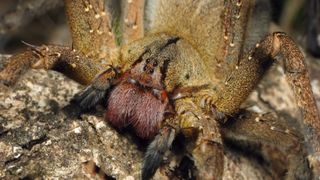
Classification/taxonomy
Size & characteristics, bites and venom, additional resources.
Brazilian wandering spiders are aggressive spiders that belong to the genus Phoneutria, which means "murderess" in Greek.
These critters, also known as armed spiders or banana spiders, are some of the most venomous spiders on Earth. Their large mouthparts, or chelicerae, inflict painful bites loaded with neurotoxic venom that can be deadly to humans — especially children — although in most cases immediate medical care can prevent death with antivenom, according to a 2018 study in the journal Clinical Toxinology in Australia, Europe, and Americas .
Brazilian wandering spiders are frequently listed among the deadliest spiders in the world . They were named the world's deadliest spiders multiple times by Guinness World Records, although the current record-holder is the male Sydney funnel-web spider ( Atrax robustus ). But "classifying an animal as deadly is controversial," Jo-Anne Sewlal, an arachnologist at the University of the West Indies in Trinidad and Tobago, previously told Live Science. Each bite is unique, and the damage it causes depends on the amount of venom injected, Sewlal said.
Jo-Anne Sewlal was a noted arachnologist from Trinidad and Tobago. While completing her PhD, she received the National Institute of Higher Education, Research, Science and Technology (NIHERST) 2012 Award for Excellence in Science and Technology for Junior Scientist. In 2013, She received a doctorate in zoology from the University of the West Indies. She discovered several species of spiders in her home country, surveyed the arachnids across several countries the Caribbean and appeared as an expert on the topic on The Science Channel. She died of an allergic reaction in January 2020.
There are nine species of Brazilian wandering spider, all of which are nocturnal and can be found in Brazil. Some species also can be found throughout Central and South America, from Costa Rica to Argentina, according to a 2008 article in the journal American Entomologist . Study author Richard S. Vetter , a research associate in the department of entomology at the University of California, Agriculture and Natural Resources, wrote that specimens of these powerful arachnids have been mistakenly exported to North America and Europe in banana shipments. However, Vetter noted, in many cases of cargo infestation, the spider in question is a harmless banana spider (genus Cupiennius ) that is misidentified as a Phoneutria . The two types of spiders look similar.
The taxonomy of Brazilian wandering spiders, according to the Integrated Taxonomic Information System (ITIS) , is:
Kingdom : Animalia
Subkingdom : Bilateria
Infrakingdom : Protostomia
Superphylum : Ecdysozoa
Phylum : Arthropoda
Subphylum : Chelicerata
Class : Arachnida
Order : Araneae
Family : Ctenidae
Genus : Phoneutria
- Phoneutria bahiensis
- Phoneutria boliviensis
- Phoneutria eickstedtae
- Phoneutria fera
- Phoneutria keyserlingi
- Phoneutria nigriventer
- Phoneutria pertyi
- Phoneutria reidyi
- Phoneutria depilata , according to a 2021 study published in the journal ZooKeys , which found that Phoneutria boliviensis actually included two separate species from different habitats.
Brazilian wandering spiders are large, with bodies reaching up to 2 inches (5 centimeters) and a leg span of up to 7 inches (18 cm), according to the Natural History Museum in Karlsruhe, Germany. The species vary in color, though all are hairy and mostly brown and gray, although some species have lightly colored spots on their abdomen. Many species have bands of black and yellow or white on the underside of the two front legs, according to the University of Florida .
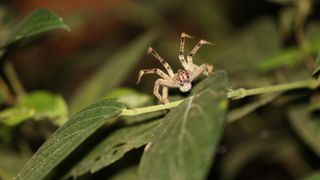
These arachnids "are called wandering spiders because they do not build webs but wander on the forest floor at night, actively hunting prey," Sewlal told Live Science in an interview conducted in 2014, before her death. They kill by both ambush and direct attack.
They spend most of their day hiding under logs or in crevices, and come out to hunt at night. They eat insects, other spiders and sometimes, small amphibians, reptiles and mice.
Research into one species of Brazilian wandering spider, Phoneutria boliviensis , revealed that these spiders eat a mix of arthropods and reptiles. DNA metabarcoding, a technique that examines the DNA and RNA in a sample, of the guts of 57 spiders identified 96 prey species, including flies, beetles, butterflies, moths, grasshoppers, locusts and crickets, according to research from the University of Tolima and the University of Ibagué in Colombia . Some of the female spiders also ate lizards and snakes.
While their bites are powerful and painful, "their bites are a means of self-defense and only done if they are provoked intentionally or by accident," Sewlal said.
When Brazilian wandering spiders feel threatened, they often assume a defensive position by standing on their hind legs and stretching out their front legs to expose their fangs, according to the 2018 study in Clinical Toxinology in Australia, Europe, and Americas. This posture is sometimes accompanied by side-to-side movements. The spiders can also jump distances up to 1.3 feet (40 cm).

In the Brazilian wandering spider, just as in most spider species, the female is larger than the male. Males approach females cautiously when attempting to mate, according to the biology department at the University of Wisconsin-La Crosse . Males perform a dance to get females' attention, and males often fight each other over the female. The female can be picky, and she often turns down many males before choosing a mating partner. Once she does pick one, the male needs to watch out; females often attack the males once copulation is finished.
The female then can store the sperm in a separate chamber from the eggs until she is ready to fertilize them. She will lay up to 1,000 eggs at a time, which are kept safe in a spun-silk egg sac.
Brazilian wandering spiders typically live for one or two years.
Brazilian wandering spiders' venom is a complex cocktail of toxins, proteins and peptides, according to the Natural History Museum in Karlsruhe, Germany. The venom affects ion channels and chemical receptors in victims' neuromuscular systems.
After a human is bitten by one of these spiders, they may experience initial symptoms such as severe burning pain at the site of the bite, sweating and goosebumps, Sewlal said. Within 30 minutes, symptoms become systemic and include high or low blood pressure , fast or a slow heart rate , nausea, abdominal cramping, hypothermia, vertigo, blurred vision, convulsions and excessive sweating associated with shock. People who are bitten by a Brazilian wandering spider should seek medical attention immediately.
Their venom is perhaps most famous for triggering painful and long-lasting erections . For that reason, in a 2023 study, scientists reported that they were testing the venom in humans as a potential treatment for erectile dysfunction in those for whom Viagra didn't work.

However, these bites are rare, and envenomations, or exposure to these toxins from a spider bite, are usually mild, Vetter said. For instance, a 2000 study in the journal Revista do Instituto de Medicina Tropical de São Paulo found that only 2.3% of people with bites who came to a Brazilian hospital over a 13-year period were treated with antivenom. (The other bites did not contain enough venom to require it.) Most of the bites were from the species P. nigriventer and P. keyserlingi in eastern coastal Brazil. About 4,000 bites reportedly happen each year in Brazil, but only 0.5% of those cases are severe, according to the 2018 study. Meanwhile, 15 deaths have been attributed to Phoneutria in Brazil since 1903, the 2018 study reported.
"It is unlikely that the spider would inject all of its venom into you, as this venom is not only needed as a means of defense but to immobilize prey," Sewlal said. "So if it did inject all of its venom, it [would] have to wait until its body manufactured more before it could hunt." That would also leave the spider vulnerable to being attacked by predators.
Furthermore, Sewlal pointed out that venom production requires a lot of a spider's resources and time. "So if the spider were to attack frequently and use up all of its venom, it [would] be safe to assume that it has a ready food supply to replace the energy and resources used. This situation does not exist in the wild."
- Learn more about Brazilian wandering spiders from the University of Wisconsin-La Crosse .
- Read about several species of Brazilian wandering spiders, including several images of the arachnids at the University of Florida .
- Find a spider in your bananas? It may or may not be a deadly species, according to the University of California, Riverside .
This article was originally published on Nov. 20, 2014.
Sign up for the Live Science daily newsletter now
Get the world’s most fascinating discoveries delivered straight to your inbox.
Jessie Szalay is a contributing writer to FSR Magazine. Prior to writing for Live Science, she was an editor at Living Social. She holds an MFA in nonfiction writing from George Mason University and a bachelor's degree in sociology from Kenyon College.
- Laura Geggel Editor
- Sascha Pare Trainee staff writer
3 remarkable spiders: A vegetarian, a vampire and a predator that uses 'pincer, fork and key'
We now know why tarantulas are hairy — to stop army ants eating them alive
South African rock art of mystery creature 'strangely flexed like a banana' might be tusked reptile that predated dinosaurs
Most Popular
- 2 Antechinus: The tiny marsupials where males have sex until they die — then females eat their corpses
- 3 3 remarkable spiders: A vegetarian, a vampire and a predator that uses 'pincer, fork and key'
- 4 When was steel invented?
- 5 Science news this week: Spiders on Mars and an ancient Egyptian sword

Fact Animal
Facts About Animals
Brazilian Wandering Spider Facts
Brazilian wandering spider profile.
There are more than 50,000 species of spider, and the vast majority are less dangerous than a honeybee. Almost none are aggressive, and of those with medically significant venom, only a small percentage are capable of causing death. So, on the whole, arachnophobes are just being a bit silly.
But there’s one spider that vindicates all of these fears, and few animals are as globally renowned to be a serious threat to human lives as the Brazilian Wandering Spider .
Brazilian Wandering Spiders are actually 9 species of spider in the same genus ‘Phoneutria’, one of which is found in Central America, with the rest in South America.
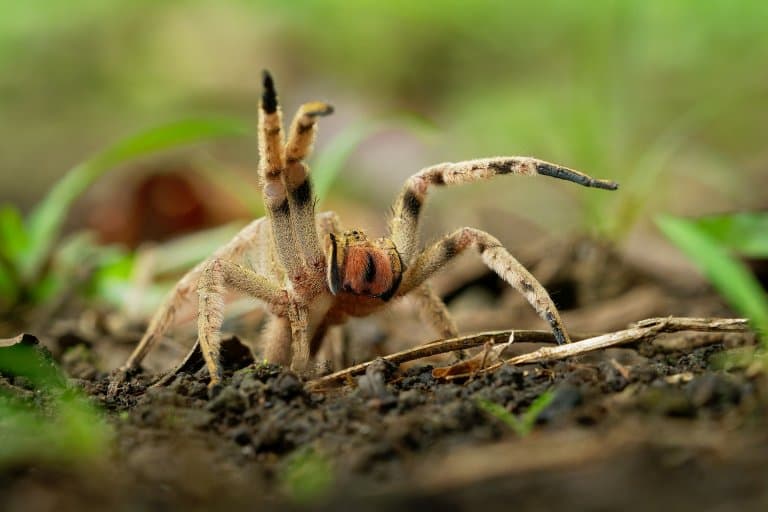
Brazilian Wandering Spider Facts Overview
These spiders are called wandering spiders because of instead of spinning a web to wait for food, or occupying a lair, they spend their night wandering in the leaf litter of the jungle floor for prey.
The sensitive hairs on its body help detect vibrations of passing prey, and it will feed on insects, lizards, frogs and any animals as large as itself.
During the day they will hide under logs, rocks, or inside termite mounds and banana plants. They will also sometimes wander into urban areas and homes, where they can come into contact with humans.
Brazilian wandering spiders are aggressive , dangerous and frightening. For once, this is an animal you should be wary of.
The females are larger, around 50% heavier than males, and produce more venom, and this might be a clue as to why their Greek name translates to “ Mudress” . These spiders will often stand and fight and have an intimidating threat display.
The potency of their venom is one of the reasons they’re so dangerous, and their ability to hide away in fruit and shoes explains why most bites are on extremities.
Interesting Brazilian Wandering Spider Facts
1. armed spiders.
In Brazilian, these are sometimes known as armed spiders, on account of their elongated front legs.
They can convey quite a bit of information with these legs, and as wandering spiders, use them to get about the forest, looking for food.
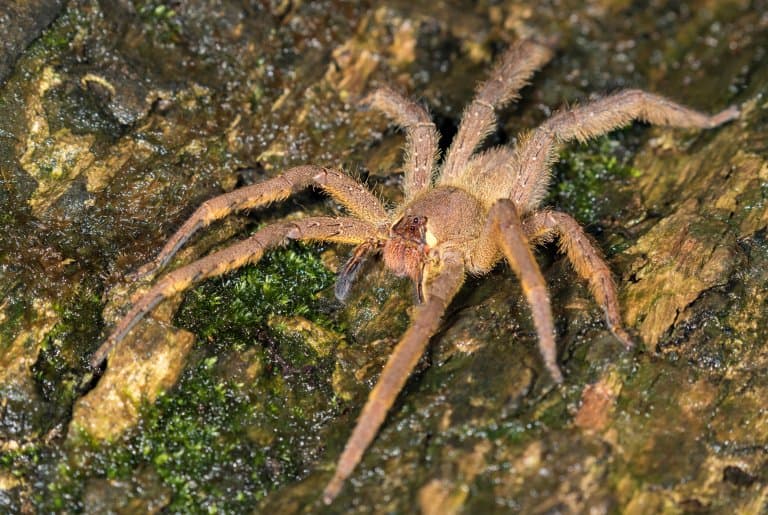
2. Banana Spiders
They’re also sometimes called ‘banana spiders’ on account of their status as a stowaway on popular fruit imported from the tropics.
This is becoming less common as stricter regulations ensure there’s less contamination of fruits, but there’s always a chance your next bunch of bananas will have a family of these spiders living inside it.
3. They have the largest venom glands of any spider
Females produce more venom than males, but both sexes have enormous venom glands. These glands are even more impressive when you consider the size of the spider is significantly less than the largest around.
The venom glands of the Brazilian Wandering Spider are over a centimetre long, and this is all housed inside the bright red chelicerae (mouth parts) which they are quick to display whenever they get upset. 1
4. They’re aggressive
These spiders can grow quite large and have long, brightly-coloured legs. Unlike most spiders, they’re known to stand their ground when threatened and are far quicker to bite than many other species.
They’ll still try to scurry away where possible, and they’re not out to get anybody.
But where most other species will flee, the wandering spiders’ aggression does make it more likely to be involved in incidents.
Most bites are on fingers and toes, a sign that they’re being stepped on or grabbed inadvertently. When the spider feels cornered, it’ll rear up on its back legs and waves its colourful arms around as a warning.
Then it’ll sway side to side, beckoning you to have a go. Anything foolhardy enough to call this bluff gets a wealth of envenomation effects. 2 3
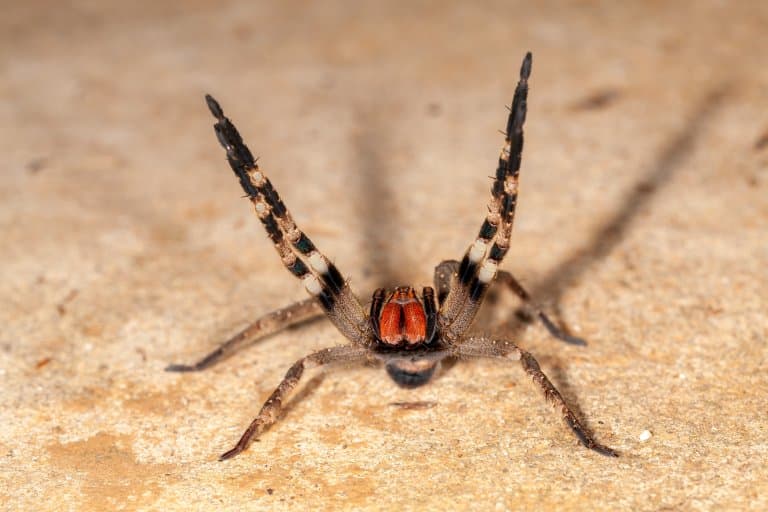
5. They give some men erections
There are ways to accomplish this with fewer side effects, but a bit from a Brazilian wandering spider does come with a certain Viagral quality.
This isn’t as fun as it might sound. Prolonged erections in this manner are likely to harm and destroy muscles and blood vessels in the penis and could cause irreparable damage.
Besides this, the assault on the central nervous system that comes with envenomation by this spider doesn’t sound worth it. 4
6. And some people die
This assault brings with it a whole host of unpleasant symptoms. Seizures, foaming at the mouth, inability to speak, collapse, and a host of other miserable experiences.
Paralysis is possible, as is cardiac shock. Blood vessels can burst in the brain, or anywhere else, and in many cases, this can be enough to kill a person.
This spider has one of the most potent venoms of all, and there are multiple legitimate records of death as a result of bites.
7. But they’re rarely fatal
While the Brazilian wandering spider is potentially one of the most dangerous spiders in the world, there is some evidence to suggest it gives a dry bite, defensively.
This means that despite exceptionally toxic venom, the amount actually injected is less than some of the other contenders, and this is what makes it typically less lethal than the Australian funnel webs.
These spiders are classified as Dangerous Wild Animals and would therefore require a special permit to keep. Bites from wandering spiders are common in South America, but antivenom is often readily available, and they rarely result in death.
In most cases, lethal bites are cases of a very young or very old victim, and few people of healthy age are killed. 5
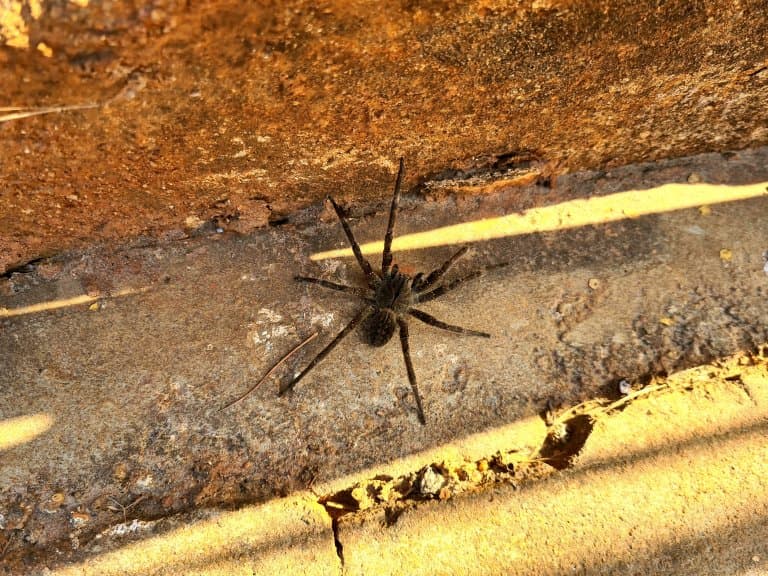
8. They do invade the UK sometimes
These unquestionably scary spiders show up in supermarkets in the UK on occasion, having hitched a ride on banana shipments.
On more than one occasion they’ve made their way into shoppers’ homes, but it doesn’t appear that there are any cases of them biting people as a result.
These spiders aren’t suited for temperate climates and don’t survive Winter, so there’s no risk of them multiplying.
Brazilian Wandering Spider Fact-File Summary
Scientific classification, fact sources & references.
- PeerJ. (2017), “ Dimensions of venom gland of largest venom glands in all spiders ”, Bio Numbers.
- Dave Clarke (2010), “ Venomous spider found in Waitrose shopping ‘beautiful but aggressive’” , The Guardian.
- “ Phoneutria Perty (Arachnida: Araneae: Ctenidae) ”, UF-IFAS University of Florida
- Kátia R.M. Leite (2012), “ Phoneutria nigriventer spider toxin Tx2-6 causes priapism and death: A histopathological investigation in mice ”, Science Direct.
- “ Brazilian wandering spiders: Bites & other facts ”, Live Science.

A home for Tarantula, Spider, Scorpion and Arachnid Enthusiasts.
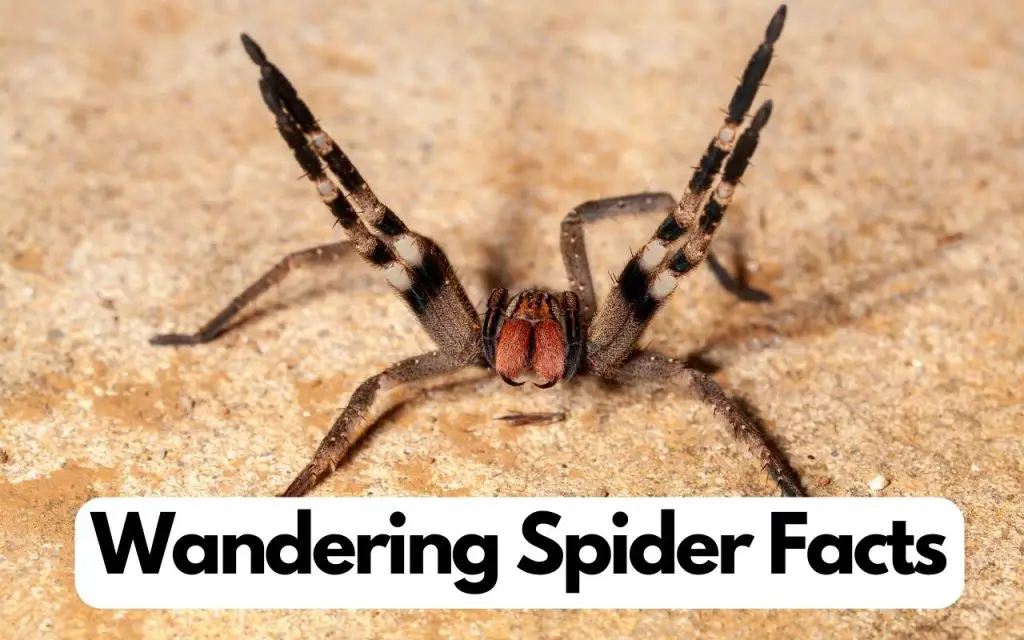
Brazilian Wandering Spider facts
Last updated on July 12th, 2023 at 01:48 pm
When you think of deadly spiders, there are a few names that spring to mind – but none more infamous than the Brazilian Wandering Spider. This species is reputed to have the most toxic venom of any spider, having a bite which causes horrendous side-effects like priapism and convulsions.
What you may not know, however, is that the Brazilian Wandering Spider name is actually used for a few species. The most common, and perhaps the most medically significant in the group are Phoneutria nigriventer and Phoneutria fera .
In this post, I’ll tell you more about these two species, from where they live, to what they eat. To keep things simple, I’ll just refer to them both as the “Brazilian Wandering Spider”, given how similar they are. Let’s dive in…
Quick Facts
To kick things off, here are some fascinating factoids about the Brazilian Wandering Spider:
- They belong to the genus ‘Phoneutria’, which translates to ‘murderess’ in Greek.
- They are known for their highly potent venom.
- Wandering Spiders are nocturnal creatures.
- They are also known as ‘banana spiders’ due to their tendency to hide in banana plants.
- They are not web-weavers but active hunters. This is called ‘cursorial’ hunting.
- It’s considered one of the most dangerous spiders in the world.
Other Common Names
The Brazilian Wandering Spider goes by several other names. The most common is the ‘banana spider’, thanks to their notorious habit of stowing away in banana shipments. In their native Portuguese, they’re known as ‘aranhas-armadeiras’ , translating to ‘armed spiders’ – a reference to their aggressive defense posture.
Brazilian Wandering Spider Venom
Possessing one of the most potent venoms among spiders, the Brazilian Wandering Spider’s bite is a cause for concern. Its venom is a complex cocktail of toxins, proteins, and peptides.
The main component that gets everyone’s attention is the neurotoxin, called PhTx3 , which can interfere with the functioning of our nervous system, leading to a variety of symptoms.
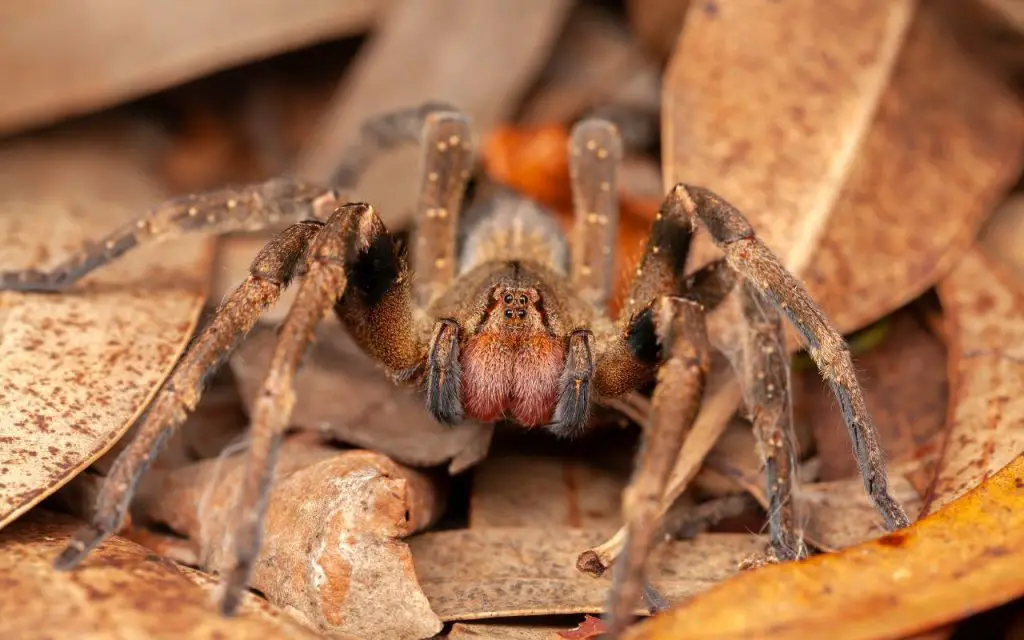
What’s the Benefit of Having Such Strong Venom?
With venom potent enough to kill a human, one might wonder why this spider needs such a powerful weapon. The answer lies in its lifestyle.
Brazilian Wandering Spiders are active hunters and their venom is primarily used to incapacitate prey quickly. The venom’s potency also serves as an effective deterrent against potential predators.
Brazilian Wandering Spider Deaths
Despite the notorious reputation, actual deaths from Brazilian Wandering Spider bites are rare. This is largely due to the rapid medical attention available in areas where these spiders are common. Plus, these spiders don’t always inject venom when they bite – a dry bite can occur.
This actually common in venomous animals, including spiders and reptiles. Occasionally they bite and decide to not inject any venom. The point of this is to conserve it, given that it is energetically costly to produce.
Brazilian Wandering Spider Size
Being quite large and impressive compared to most arachnids, adult Brazilian Wandering Spiders can reach a leg span of up to 7 inches (18 cm) . The body size excluding the legs can be up to 2 inches (5 cm). Their size contributes to their intimidating presence.
If you’d to learn more about why they get so big, check out my article on Brazilian Wandering Spider size for more info!
Brazilian Wandering Spider Location and Habitat
Brazilian Wandering Spiders are native to South America. Here’s a quick rundown of their range and preferred habitats:
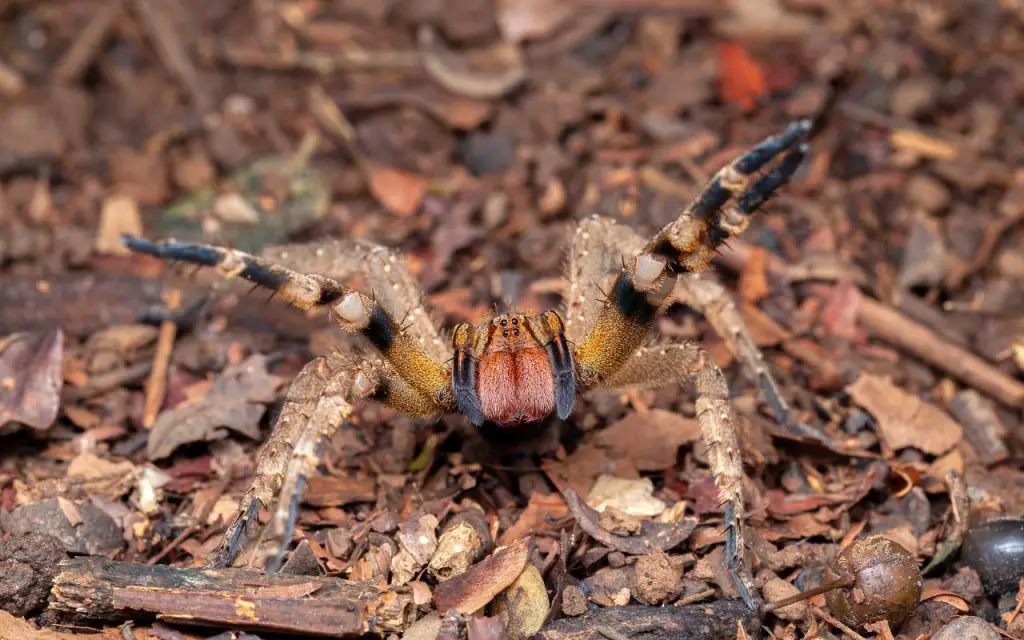
Brazilian Wandering Spider Speed
An adept hunter, the Brazilian Wandering Spider can move quickly when chasing prey or evading threats. While exact speed measurements can vary, some sources report that these spiders can achieve speeds up to 1 meter per second.
What Does the Brazilian Wandering Spider Eat?
The Brazilian Wandering Spider’s diet consists mainly of insects, other spiders, and occasionally small amphibians and reptiles. Their potent venom allows them to tackle prey larger than themselves, making them one of the apex micro-predators in their habitat.
Final Thoughts…
While the Brazilian Wandering Spider might seem terrifying to many, as an arachnid enthusiast, I find them to be incredibly fascinating. Their potent venom, hunting prowess, and adaptation to diverse habitats reveal the intricate beauty of the evolutionary process.
Just remember, these spiders, like all creatures, play a vital role in our ecosystem. Respect, not fear, should be our response to these remarkable arachnids.
The truth is that most bites are accidental, but they do occur. The fact that so few deaths occur each year is a testament to the effectiveness of the antivenom that has now become widely available.
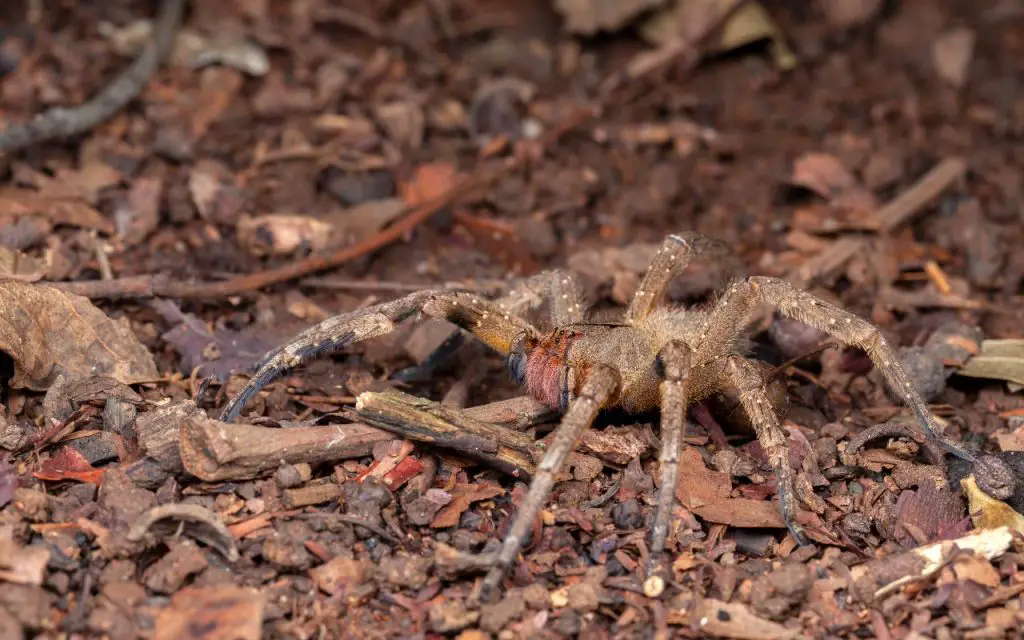
FAQ related to the Brazilian Wandering Spider
What happens if you are bitten by a brazilian wandering spider.
Immediately after a bite from a Brazilian Wandering Spider, you will experience localized pain. Then, within 5 to 15 minutes the area around the bite will swell. The swelling can spread to most of a limb, for example. Finally, neurological symptoms like coldness, sweating, and convulsions will set in.
Do wandering spiders jump?
Wandering Spiders are excellent at jumping. They can jump several feet when surprised, and may occasionally use this as a tactic to evade predators. Jumping at you isn’t part of how bites happen though. When faced with humans, Wandering Spiders usually stand their ground and use their threat display of raised legs to warn us away.
Is Brazilian wandering spider friendly?
Wandering Spiders are not friendly. As a general rule, they are relatively calm, but can also be defensive. They tend to see humans as a threat, and will not take to being handled easily. That said, they are not aggressive, and most bites happen when someone accidentally touches one or tries to kill it.
Are Brazilian wandering spiders in Australia?
Brazilian Wandering Spiders are not found in Australia. The only species in Australia that get as large as Wandering Spiders are the Huntsman Spiders. At a distance they may appear relatively similar, but Huntsman Spiders are completely harmless to humans.
Related Posts:
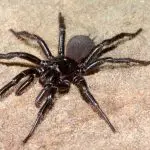
Leave a Comment Cancel Reply
Your email address will not be published. Required fields are marked *
Save my name, email, and website in this browser for the next time I comment.

Wellcome to SpiderZoon
- Spider Facts
Brazilian Wandering Spider: Size, Bite, Diet and Other Facts
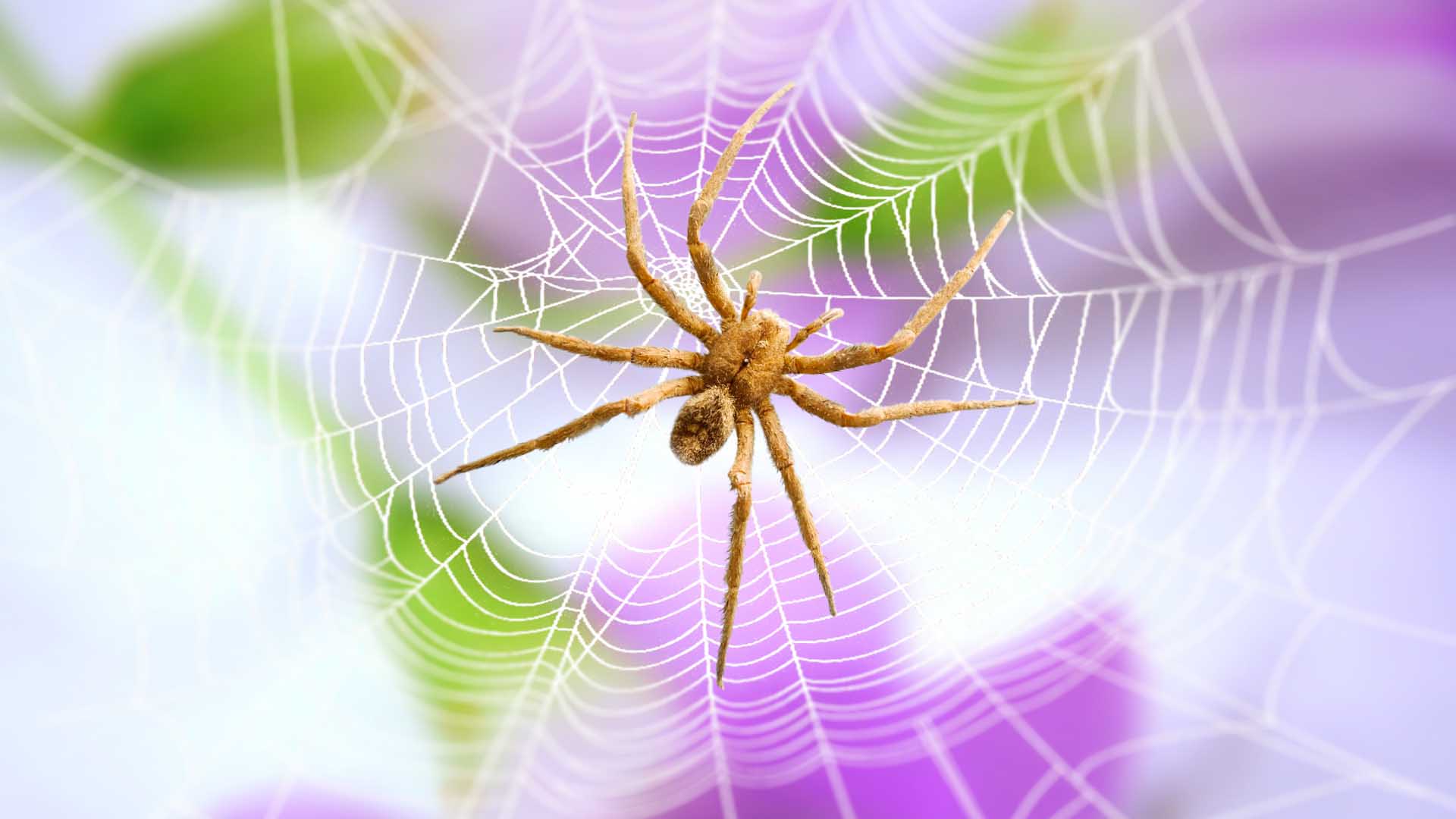
The Brazilian Wandering Spider is a venomous arachnid with a fearsome reputation. This South American rainforest dweller packs a powerful punch, but don’t let its nickname “banana spider” fool you – they’re active hunters, not web-spinners. Despite their size and venom, bites are uncommon as they’re typically shy.
The Brazilian Wandering Spider has garnered significant attention due to its potent venom, which makes it one of the world’s most venomous spiders. Understanding its biology and behavior is crucial for both scientific research and public safety.
Scientific classification
The Brazilian Wandering Spider belongs to the family Ctenidae within the order Araneae. Its scientific classification is as follows:
- Kingdom: Animalia
- Phylum: Arthropoda
- Class: Arachnida
- Order: Araneae
- Family: Ctenidae
- Genus: Phoneutria
The Brazilian Wandering Spider goes by various common names, including “armed spider,” “banana spider,” and “wandering spider.” Synonyms for this species may include Ctenus , which was formerly used for some Phoneutria species.
Distribution and habitat
Distribution:
- South American: Found throughout most of South America east of the Andes mountains, including countries like Brazil (their namesake), Argentina, Paraguay, and up into northern regions.
- Central American Touch: A few species even reach southern Central America.
- Rainforest Dwellers: Primarily found in the lush rainforests of South America.
- Not Picky Places: They can also adapt to other habitats like the Atlantic Forest and even some urban areas.
- Daytime Hideouts: While they wander at night, they seek shelter during the day in places like termite mounds, under rocks, or even (unintentionally) in bananas!
Physical Characteristics
size and weight.
The Brazilian wandering spider is a creepy crawly giant. Their bodies can grow up to 2 inches (5 centimeters) long, but that’s not the scary part. Their legs can span a whopping 7 inches (18 cm), making them look even bigger. They are one of the biggest true spiders by body weight and size.
Despite their impressive leg span, Brazilian wandering spiders are relatively light. They only weigh around 6 grams, which is about the same as two pennies. While they might look imposing, they’re not the heaviest arachnids around.
Coloration and markings
These spiders exhibit a range of colors, including brown, black, and sometimes reddish hues. They often have distinctive markings on their bodies, which can vary between species. These markings may include stripes or patterns that serve as a key identification feature.
Notable features
One of the most notable features of the Brazilian Wandering Spider is its elongated, robust body and long, agile legs. They have sharp fangs, which they use to inject venom into their prey or in self-defense.
Sexual dimorphism
Sexual dimorphism is evident in this species. Females are larger and bulkier than males, while males have longer, more slender legs. Additionally, males possess specialized structures known as pedipalps, which are used during mating.
In the following sections of this article, we will delve deeper into the behavior, venom, and ecological role of the Brazilian Wandering Spider, shedding light on why this species has both fascinated and instilled fear in those who encounter it.
Behavior and Ecology
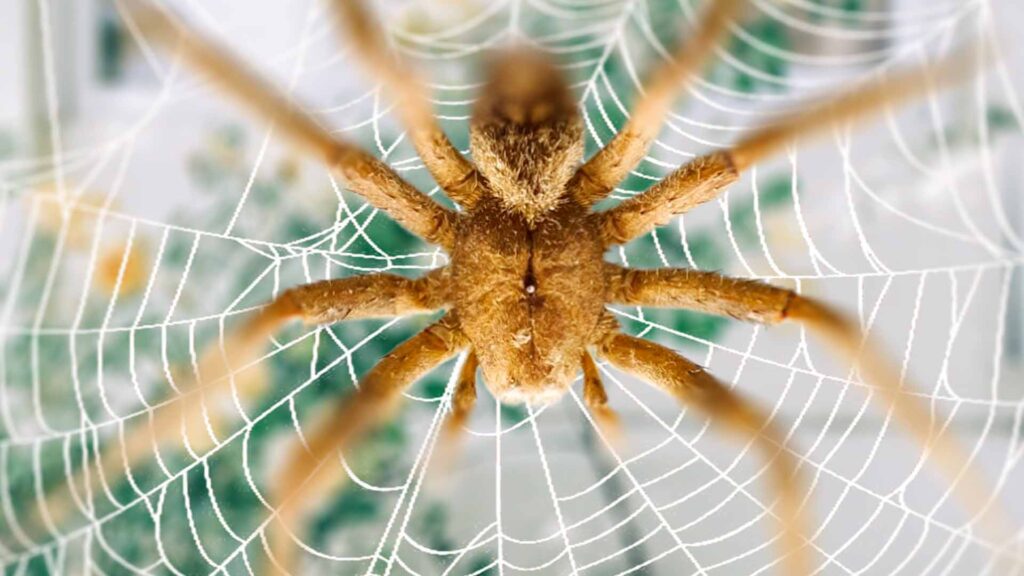
Nocturnal habits
Brazilian Wandering Spiders are primarily nocturnal creatures. They are most active during the night, venturing out of their daytime hiding places to hunt for prey and engage in mating activities. Their nighttime activity allows them to avoid predators and reduce the risk of desiccation in the hot tropical sun.
Hunting and feeding behavior
These spiders are agile hunters and primarily feed on insects, small vertebrates, and other arachnids. They do not build webs to capture prey but instead rely on their excellent senses, including acute vision and touch, to locate and stalk their victims. They often wander in search of food and are known for their swift and lethal strikes. Once they subdue their prey, they inject venom to immobilize it before feeding.
Brazilian Wandering Spiders (Phoneutria) are active hunters and have distinctive feeding behaviors. Here’s an overview of their feeding habits:
- Active Predators: Brazilian Wandering Spiders are not web-builders like many other spider species. Instead, they are active predators. They actively roam their environment in search of prey rather than waiting for insects to stumble into a web.
- Hunting Strategy: When hunting, these spiders use their excellent senses, including acute vision and touch, to locate potential prey. They are known for their agility and speed, which they use to stalk and capture their victims. They have sharp fangs, which they use to deliver a venomous bite to immobilize their prey.
- Diet: Their diet consists primarily of insects and other arthropods, but they are opportunistic feeders and may consume a variety of small creatures, including small vertebrates such as frogs and lizards when the opportunity arises.
- Venom Use: Brazilian Wandering Spiders inject venom into their prey to immobilize and partially digest it. Their venom contains neurotoxins that affect the nervous system of their victims. Once the prey is incapacitated, the spider can feed on it at its leisure.
- Feeding Process: After subduing their prey with a venomous bite, the spider uses its chelicerae (fangs) to break down the prey’s tissues. The venom also helps in predigestion, turning the prey’s insides into a semi-liquid form that the spider can ingest. They can consume both the internal fluids and solid parts of their prey.
- Frequency of Feeding: The frequency of feeding can vary depending on factors such as the availability of prey and the spider’s size. Generally, they need to feed periodically to sustain their energy and growth. Spiderlings may require more frequent meals to support their rapid growth, while adults can go longer periods between meals.
Overall, the Brazilian Wandering Spider’s feeding strategy is well-suited for their active and wandering lifestyle, allowing them to efficiently capture and consume a variety of prey in their natural habitat.
Role in the ecosystem
The Brazilian Wandering Spider plays a vital role in controlling insect populations within its habitat. By preying on a variety of insects and other small creatures, they help maintain ecological balance. Additionally, their presence in the rainforest ecosystem contributes to the overall biodiversity and food web.
Mating and reproduction
Mating in Brazilian Wandering Spiders is a complex and potentially dangerous process. Male spiders must carefully approach and court a receptive female to avoid being mistaken for prey. They use specialized pedipalps to transfer sperm to the female’s reproductive organs. After successful mating, females lay egg sacs containing hundreds of eggs. They guard these sacs and ensure the survival of their offspring until they hatch.
Lifespan and growth
The lifespan of Brazilian Wandering Spiders varies between males and females. Males generally have a shorter lifespan, typically living for a few months to a year after reaching maturity. Females, on the other hand, can live for several years. The growth of these spiders involves a series of molts, during which they shed their exoskeletons to accommodate their increasing size. Molting is a vulnerable period in their lives as their new exoskeleton is initially soft and requires time to harden.
Venom and Envenomation
Composition of venom.
The venom of Brazilian Wandering Spiders is a complex mixture of neurotoxins, cytotoxins, and other enzymes. One of the most significant components is a neurotoxin called PhTx3, which targets the nervous system of their prey.
Toxicity and effects on humans
The venom of these spiders is highly potent and can be lethal to their prey. In humans, envenomation can cause a range of symptoms, including intense pain, muscle cramps, fever, nausea, and in severe cases, paralysis and death. It’s important to note that while their venom is potent, actual fatalities from Brazilian Wandering Spider bites are rare due to the availability of medical treatment.
First aid and medical treatment
In the event of a Brazilian Wandering Spider bite, immediate medical attention is crucial. First aid measures may include cleaning the wound and applying ice to reduce pain and swelling. However, the primary treatment involves antivenom, which can counteract the effects of the spider’s venom.
Cases of envenomation and fatalities
Although fatalities from Brazilian Wandering Spider bites are uncommon, there have been documented cases of severe envenomation, especially in regions where medical treatment is not readily available. These spiders are generally non-aggressive and will bite humans only in self-defense when provoked, or if they feel cornered.
Understanding the behavior, ecology, and venomous nature of the Brazilian Wandering Spider is crucial for both scientific research and public awareness, helping to minimize the risk of envenomation and promote coexistence with this remarkable but potentially dangerous arachnid.
Brazilian wandering spider life cycle
The Brazilian wandering spider has a fascinating life cycle that revolves around hunting and motherhood. Here’s a breakdown:
- Egg Haven: After mating, the female lays hundreds, sometimes even a thousand, eggs in a silken sac. This becomes their protected nursery.
- Tiny Terrors: Hatching from the eggs emerge translucent spiderlings called larvae.
- Nymph Stage: The larvae molt a few times, transforming into nymphs. Think of them as mini-adults but without the ability to reproduce yet.
- Shedding for Size: As nymphs grow, they undergo multiple molts, shedding their outer shell to accommodate their larger bodies.
- Ready to Roam: After the final molt, the spider emerges as a full-fledged adult, complete with reproductive organs. Now, they can join the wandering lifestyle and continue the cycle.
The life cycle begins when a female Brazilian Wandering Spider lays her eggs. She typically creates an egg sac made of silk and deposits it in a concealed location, such as a tree hollow or leaf litter. Inside the sac, she may lay hundreds of eggs. The female guards the egg sac and ensures its protection until the spiderlings hatch. The duration of the egg stage varies depending on environmental conditions but generally lasts for a few weeks.
Spiderling Stage
After the incubation period, spiderlings (young spiders) emerge from the egg sac. They are extremely vulnerable at this stage and rely on their mother’s protection and guidance. Spiderlings are miniature versions of adult spiders but lack the full coloration and size. They disperse from the nest once they have molted and are capable of hunting on their own. During this stage, they grow rapidly by molting, shedding their exoskeletons to accommodate their increasing size.
Juvenile Stage
As spiderlings continue to molt and grow, they progress into the juvenile stage. During this phase, their coloration becomes more distinct, and they start to develop the characteristic features of adult Brazilian Wandering Spiders. They become increasingly independent and begin to exhibit hunting behaviors. The duration of the juvenile stage can vary but often lasts several months.
Sub-Adult Stage
The sub-adult stage is an intermediate phase between juvenile and adult. At this point, the spiders are closer in size and appearance to adults but have not yet reached sexual maturity. They continue to molt, with the frequency of molting gradually decreasing as they approach adulthood. Sub-adult spiders may exhibit more territorial behaviors as they compete for resources and prepare for eventual mating.
Adult Stage
Upon reaching sexual maturity, Brazilian Wandering Spiders enter the adult stage. This is when they are fully developed and capable of reproduction. Females are larger and bulkier than males, and males possess specialized structures called pedipalps, which they use during mating. Adult spiders engage in mating activities, and females lay eggs to continue the life cycle. Adult Brazilian Wandering Spiders can live for several years, with females typically having longer lifespans than males.
Understanding the life cycle of these spiders is essential for studying their behavior, reproductive biology, and population dynamics. It also provides insights into their adaptation strategies in the complex ecosystems of South and Central America.
Brazilian Wandering Spider Bite
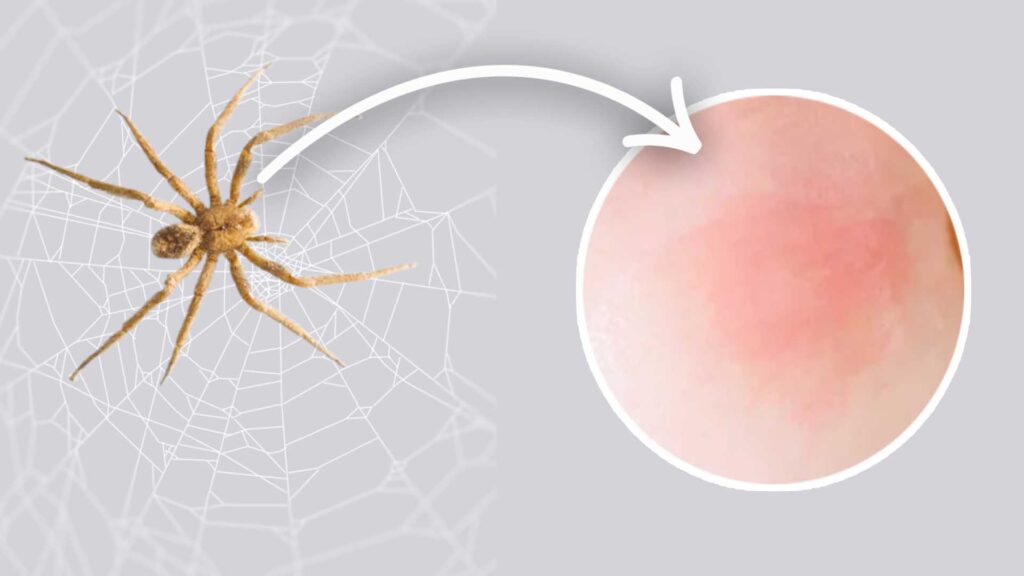
Brazilian Wandering Spiders are known for their potent venom and, occasionally, their bites on humans. While bites are relatively rare due to the spider’s non-aggressive nature, understanding the consequences of a bite is crucial for public safety.
Studying Brazilian Wandering Spider bites is of great interest for several reasons. It helps healthcare professionals provide appropriate medical treatment, raises awareness among communities in spider habitats, and contributes to our understanding of venomous arachnid envenomations.
The venom of Brazilian Wandering Spiders is a complex mixture of neurotoxins, cytotoxins, and enzymes. It contains various components, including PhTx3, which is a potent neurotoxin affecting the nervous system.
Brazilian Wandering Spider bites can have a range of effects on the human body, including intense pain, muscle cramps, fever, nausea, and in severe cases, paralysis. The severity of the symptoms depends on factors such as the amount of venom injected and the individual’s sensitivity to the venom. There are several types of spider bites .
Symptoms of a Brazilian Wandering Spider Bite
Local symptoms
- Intense pain
- Itching or burning sensation
- Formation of blisters or lesions
Systemic symptoms
- Muscle cramps and spasms
- Abdominal pain
- Nausea and vomiting
- Elevated heart rate
- Hypertension (high blood pressure)
- Respiratory distress
Severity and variations
The severity of Brazilian Wandering Spider bite symptoms can vary widely. In some cases, symptoms may be mild and resolve on their own, while in severe envenomations, life-threatening complications can occur. Individual reactions to the venom can also vary, making it challenging to predict the exact outcome of a bite.
First Aid and Immediate Response
Steps to take after a bite
Immediate response to a Brazilian Wandering Spider bite should include:
- – Washing the bite area with soap and water.
- – Applying a clean, cool compress to reduce pain and swelling.
- – Immobilizing the affected limb or area.
- – Keeping the bite victim calm to prevent an elevated heart rate.
Do’s and don’ts in case of a bite
- – Seek medical attention promptly.
- – Take note of the spider’s appearance (if possible) to aid identification.
- – Keep the bite victim still and calm to reduce the spread of venom.
- – Do not try to suck out venom or make incisions at the bite site.
- – Avoid applying tourniquets.
- – Don’t use ice directly on the skin as it can worsen tissue damage.
Seeking medical attention
Medical attention is essential after a Brazilian Wandering Spider bite, even if symptoms appear mild initially. Antivenom is available and can be administered to counteract the effects of the venom. Medical professionals can also manage symptoms and monitor for potential complications.
Complications and Long-Term Effects
Potential complications
Complications from Brazilian Wandering Spider bites can include:
- – Severe muscle spasms
- – Respiratory distress
- – Cardiovascular issues
- – Kidney failure (rare)
- – Allergic reactions to antivenom
Long-term consequences
Long-term consequences of a bite can vary depending on the severity and medical treatment received. Some individuals may experience lingering pain, muscle weakness, or psychological trauma following a severe envenomation.
Recovery and rehabilitation
Recovery from a Brazilian Wandering Spider bite typically involves medical treatment, rehabilitation for muscle and nerve damage, and psychological support for individuals affected by the experience. Rehabilitation may include physical therapy to regain muscle strength and function. Prompt medical attention and appropriate care are crucial for minimizing long-term effects and complications.
Facts of Brazilian Wanding Spider
Here are 10 creepy crawly facts about the Brazilian Wandering Spider:
- Big and Hairy: These spiders are giants! Their bodies can grow up to 2 inches (5 centimeters) long, with a leg span of up to 7 inches (18 cm). They are covered in hairs, making them appear even bigger.
- Wanderlust: They are aptly named – Brazilian wandering spiders don’t spin webs. Instead, they wander the forest floor at night in search of prey.
- Venomous Bite: Their venom is considered one of the most potent among spiders. A bite can cause severe pain, swelling, sweating, nausea, and even priapism in males. Thankfully, bites are rare as they are typically shy and defensive.
- Not So Fond of Bananas: While sometimes called ‘banana spiders,’ they are not typically found in bananas. They might, however, take shelter in them during transport, which is how they might end up in a faraway land.
- Rainforest Resident: These spiders are native to the rainforests of South America, particularly in Brazil.
- Fearsome Feasters: They’re active hunters and will eat almost anything they can overpower, including insects, lizards, frogs, and even small rodents.
- Mom’s the Word: Female Brazilian wandering spiders are dedicated mothers. They lay hundreds of eggs in a silken sac and fiercely guard them until they hatch.
- Multiple Molts: Like all spiders, Brazilian wandering spiders grow through molting. They shed their exoskeleton multiple times as they grow into adults.
- Mating Dance: Male Brazilian wandering spiders perform a elaborate mating dance to attract a female.
- Medicinal Potential: Despite their scary reputation, the venom of the Brazilian wandering spider is being studied for its potential use in treating erectile dysfunction.
What happens if a Brazilian Wandering Spider bites a man?
A Brazilian Wandering Spider bite on a man can cause a range of symptoms, some severe:
- Pain: The bite is known for causing intense, localized pain at the site.
- Autonomic effects: Sweating, nausea, and increased heart rate are common.
- Priapism: In some cases, males may experience a prolonged and painful erection (priapism). This is due to a component in the venom.
- Muscle paralysis: Severe bites can lead to muscle paralysis, which can affect breathing in rare cases.
However, it’s important to remember:
- Bites are uncommon as these spiders are typically shy and defensive.
- Antivenom is available and effective in treating bites.
If bitten, seek medical attention immediately. Early treatment can help prevent complications and ensure a full recovery.
How poisonous is a Brazilian Wandering Spider?
Brazilian Wandering Spider packs a nasty venomous punch, considered one of the strongest among spiders. Bites are rare though, as they’re shy and prefer to escape trouble.
What is the world’s deadliest spider?
The term “deadliest” can be subjective and depends on how one defines it (e.g., based on venom potency or human fatalities). However, the Brazilian Wandering Spider (Phoneutria) is often considered one of the most venomous spiders in the world. Another spider often mentioned in discussions of venom toxicity is the Sydney Funnel-web Spider (Atrax robustus and Atrax formosus), found in Australia. These spiders are known for their potent venom and have caused fatalities in the past.
FAQ about Brazilian Wandering Spider
Are brazilian wandering spiders endangered of extinction, leave a reply cancel reply.
Your email address will not be published. Required fields are marked *
Save my name, email, and website in this browser for the next time I comment.
Related Article
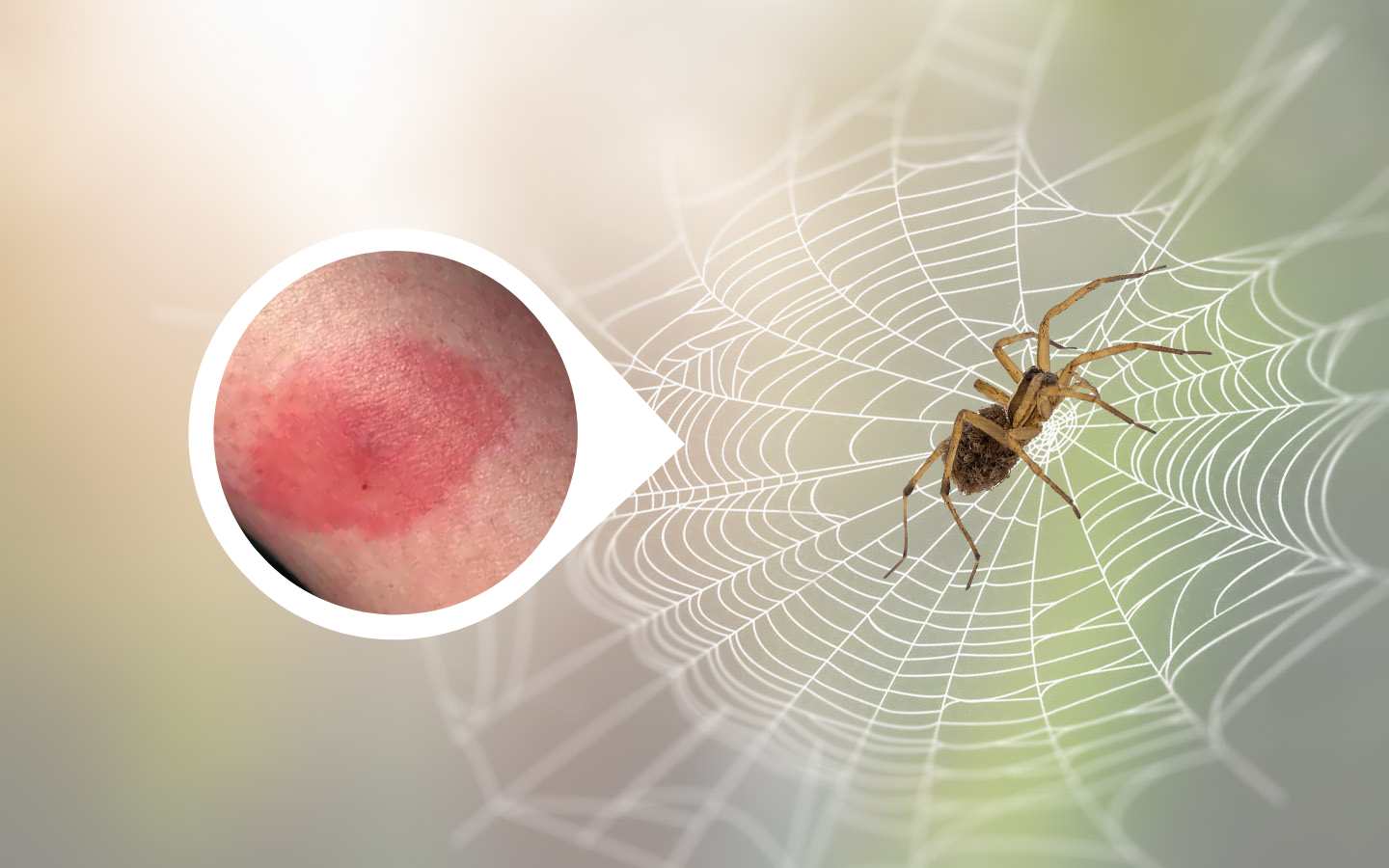
Wolf Spider Bite: Stages and Symptoms with Pictures
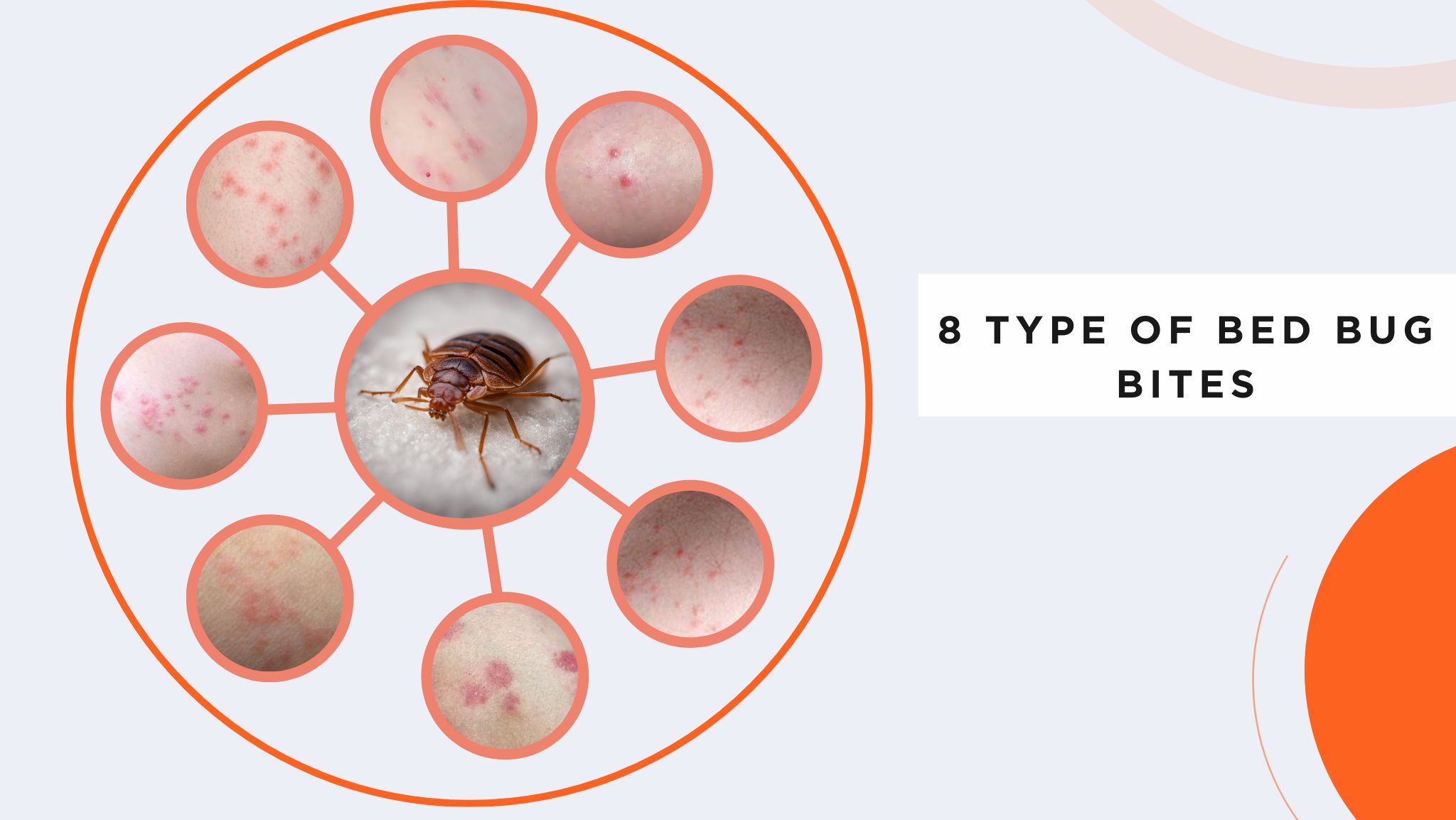
8 Type Of Bed Bug Bites: Identification Chart with Picture
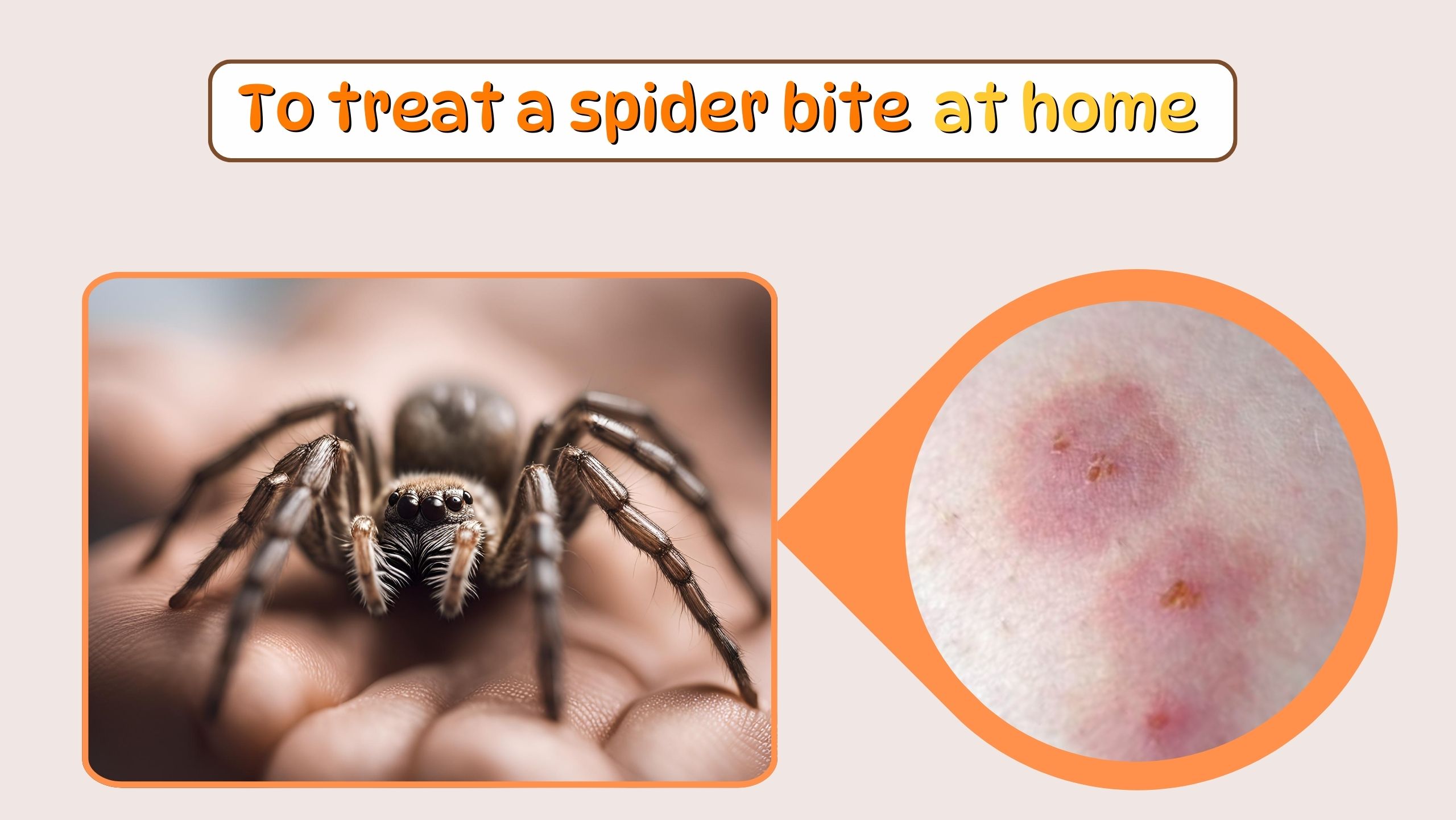
What Can I Do At Home For a Spider Bite? (Simply Do it)
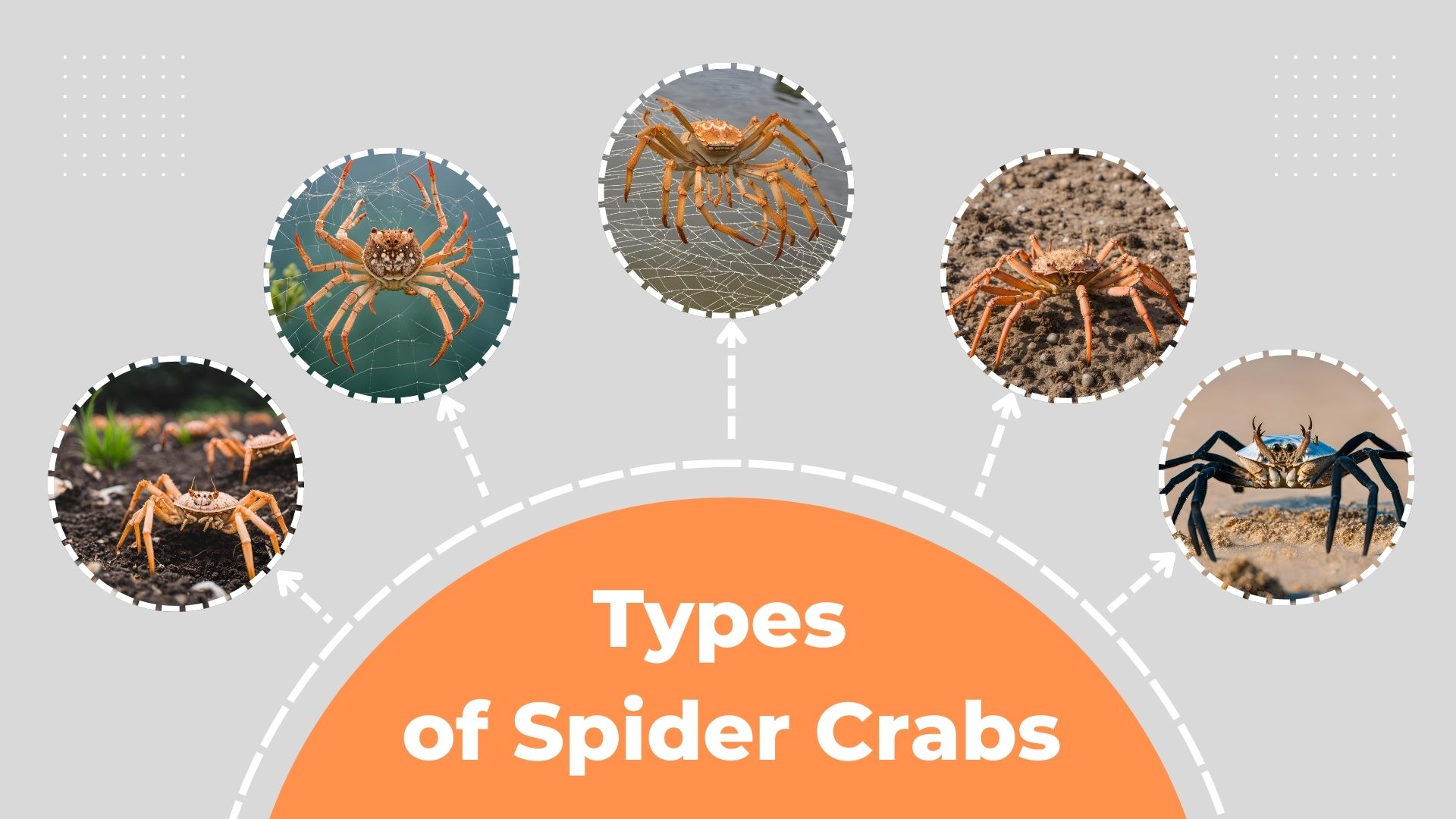
Spider Crabs: Types, Characteristics, and ID (With Pictures)

Brazilian Wandering Spider: Care, Food, Habitat & Preventions
Mike Wallace
Have you ever heard of or do you know what a Brazilian wandering spider is ? It is a big venomous spider from places like Central and South America, and people sometimes call it the banana spider . Why? Well, we are about to find out!
Table of Contents
These wandering spiders are aggressive hunters who go out on the hunt at night. Their meals include both invertebrates (like insects) and vertebrates (creatures with a backbone, like small animals).
These spiders are super dangerous because their venom is like a powerful potion that can make people really sick or even worse. They usually hang out in tropical rainforests and even in cities, hiding in banana plants.
So, let’s get more information about the world of this sneaky spider to learn the details about its looks, eating habits, where it lives, the venom it carries, and find out if it is genuinely risky. Ready to explore? Keep reading!
Brazilian Wandering Spider Description:
Scientific name and family:.
In Brazil, they are sometimes known as “ armed spiders ” (armadeiras), and they share the name “ banana spiders ” with a few other spiders. They have different names, but they are all talking about the same interesting spider!
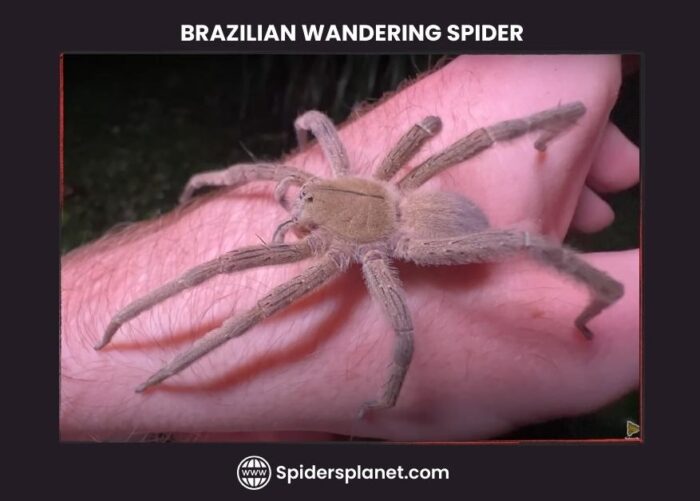
The Brazilian wandering spider, scientifically known as Phoneutria , Maximilian Perty kickstarted the Phoneutria genus in 1833. The name comes from the Greek word φονεύτρια , which means “murderess” and falls under the Animalia kingdom, Arthropoda phylum, and Arachnida class.
Within Arachnida, it is classified in the order Araneae, infraorder Araneomorphae, and Ctenidae family. The genus Phoneutria, described by Perty in 1833, includes the type species Phoneutria fera .
This classification helps us understand where these spiders fit into the larger picture of living organisms.
The following 9 species are accepted by The World Spider Catalog :
- Phoneutria bahiensis
- Phoneutria boliviensis
- Phoneutria eickstedtae
- Phoneutria fera
- Phoneutria keyserlingi
- Phoneutria nigriventer
- Phoneutria pertyi
- Phoneutria reidyi
- Phoneutria depilata
What do Brazilian Wandering Spider look like?
Size range:.
The spiders in the Phoneutria group can get pretty big in size. Their legs can stretch out to be 13 to 18 centimeters (5 to 7 inches) wide, and their bodies can have a range between 17 to 48 millimeters (a little more than half an inch to almost 2 inches) long.
The female Brazilian spiders can get pretty big, reaching up to 15 centimeters (5.9 inches) in length. On the other hand, the males are smaller, usually measuring around 7 centimeters (2.8 inches). They usually weigh up to 0.21 ounces.
They have long, slender legs, and even though some other spiders with different names might have longer legs, the Phoneutria spiders are champions when it comes to having the longest bodies and being the heaviest in their spider gang.
The spider’s body has two main parts. The first is the prosoma, kind of like its “head,” where you will find all eight legs, eyes, fangs (chelicera), and little multitasking arms (pedipalps).
The second part is the opisthosoma, holding the spinnerets for making silk, the back end opening (anal opening), “the lungs,” the heart, and the important bits for making baby spiders (reproductive organs).
So, the prosoma is like the front control center, and the opisthosoma is like the back office, handling things like silk-making and baby-making.
Brazilian spiders come in different colors, with most being hairy and shades of brown and gray. Some species may have lightly colored spots on their abdomen.
A distinctive feature of many species is the presence of bands of black and yellow or white on the underside of their two front legs.
Identification:
To identify a spider from the Phoneutria group, look for a dense brush of fine hairs on their leg parts. They might seem like other spiders, especially Cupiennius , but here is how you can differentiate:
- Phoneutria often have a dark line on the front of their palps and a thin black line on top of their head.
- Check underneath, too; their legs usually have dark parts and light joints. Sometimes, the belly has black dots or is reddish.
- Usually it has been observed that when they are upset, they do a cool defensive move like lifting their front legs high with a distinctive pattern. So, if you see a spider doing that dance, it is probably a Phoneutria!
Brazilian Wandering Spiders live all over the Americas, from Costa Rica to northern Argentina. They are like the residents of the jungle, chilling in forests east of the Andes in countries like Colombia, Venezuela, Ecuador, Peru, Bolivia, Brazil, Paraguay, and the Guianas.
Some, like P. reidyi, P. boliviensis, and P. fera, love the Amazon rainforest, while others prefer the Atlantic Forest in Argentina, Paraguay, and Brazil.
They have also made themselves at home in the Cerrado savanna. But if you head to northeastern Brazil, they are not around. These spiders have even taken trips to Chile and Uruguay.
Why are they called Banana Spiders?
These spiders are linked with bananas. Richard S. Vetter, a researcher at the University of California, found that these powerful spiders sometimes end up in North America and Europe by accident, hitching a ride in banana shipments.
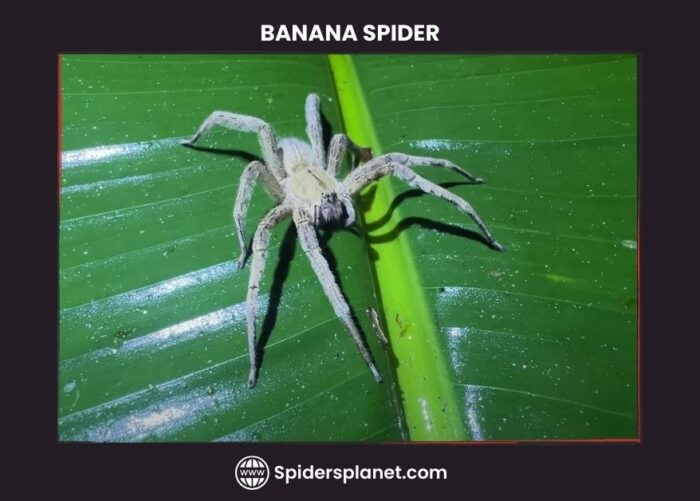
But it is often a case of mistaken identity. Only a few Phoneutria species have been found in banana shipments, and sometimes, other spiders get the blame due to misidentification.
What They Like to Eat or Hunt?
Their food includes flies, beetles, butterflies, moths, grasshoppers, locusts, and crickets. Occasionally, they might even feast on small creatures like amphibians, reptiles, or mice. All these diet or food findings tell us about how diversified eating habits these fascinating spiders have.
Mating and Lifecycle:
Like most spiders, the female spiders are bigger than the males. When the male spider wants to be friends, they do a little dance (vibrating his pedipalps and specialized sensory appendages) to signal his intentions to impress the female, but it is a cautious approach.
The behavior of the female can be choosy, and she might say no to a few before picking the right one.
After the dance, sometimes, the females decide to attack them, or if she is interested, she can store the male’s baby-making material in a special place until she is ready to use it.
Then, she lays a bunch of eggs, up to 1,000 at a time, and keeps them safe in a silk egg sac. Sadly, after laying her eggs, the mom spider says goodbye. It is her way of making sure the new spiders are ready to explore the world on their own.
The lifespan of the banana spider (Phoneutria nigriventer) differs for males and females. Females usually live for 6 to 8 weeks after reaching maturity, while males have a shorter lifespan of 2 to 3 weeks after their last molt.
Certain mammals, like coatis (Procyonidae, which includes raccoons) and other small insectivores, birds are potential predators of large wandering spiders.
These spiders got their name as wandering spiders because of the fact that they are not into web building. Instead, they stroll around the forest floor at night(nocturnal), searching for dinner.
Brazilian Wandering Spiders are active hunters and use both ambush tactics and direct attacks to catch their prey. During the day, they prefer cozy spots like under logs or in crevices, only emerging at night for their hunting adventures. These spiders do not build nests like other spider species.
While wandering spiders are not naturally aggressive towards humans, they won’t hesitate to bite if they feel cornered or threatened. Most bites happen when a spider accidentally gets trapped in clothing or bedding.
Bite and Venom:
The bite of the armed spider is the most dangerous in the world as the venom it carries can be harmful to humans.
The danger is not just about how strong the venom is; it is also about factors like the spider’s likelihood to bite and how close it is to where people live.
These spiders often hide in houses, clothes, and other dark places during the day, making accidental bites more likely.
While their fangs are adapted for small prey, some experts think they might give a “dry” bite in defense to save venom. Studies suggest that not all bites inject venom, and serious cases requiring antivenom are rare.
However, there have been confirmed cases of death, with symptoms appearing quickly, including:
- Severe pain
- Breathing difficulties
- Increased heart rate and blood pressure
- In severe cases, paralysis and death
The severity can depend on the spider’s sex, with females generally more dangerous. The spiders produce less venom in colder months, and a small amount can be potent enough to harm.
Fortunately, bites from Brazilian spiders are rare, and when they do occur, the exposure to the toxins is generally mild, as explained by Vetter.
Also Read: What is a Huntsman Spider? (Heteropodidae) – The Ultimate Guide
Banana Spider’s Facts:
Below are essential details about Brazilian wandering spiders:
- They hold the title for the world’s largest spiders , boasting leg spans reaching up to 15 centimeters (6 inches).
- Their venom packs a powerful punch, capable of inducing severe pain, paralysis, and, in extreme cases, fatal outcomes for humans.
- Despite their intimidating reputation, they are generally non-aggressive and resort to biting only when provoked.
- These spiders inhabit tropical rainforests and urban areas across Central and South America.
- In case someone has been bitten by this spider, he/she needs quick medical treatment to control the effects timely.
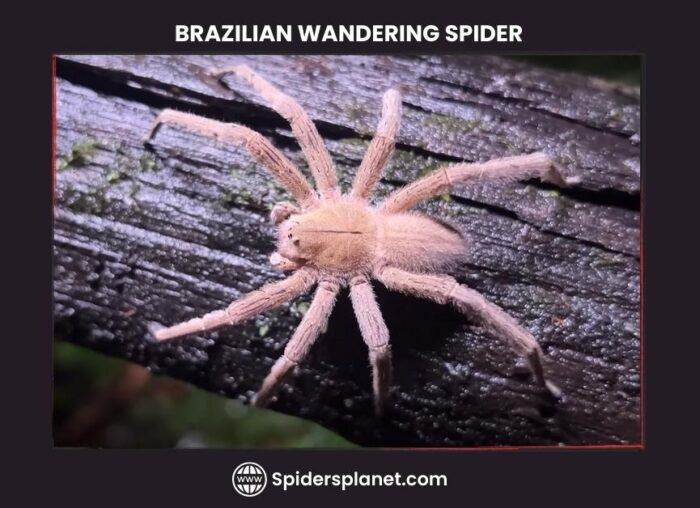
Treatment and Preventive Measures:
If bitten by a wandering spider or armed spiders, prompt medical attention is crucial. There is an antivenom for the spider’s venom, but its effectiveness is highest when administered within a few hours of the bite.
To prevent a bite:
- Wear protective clothing, use shoes and long pants when in areas where these spiders are found.
- Before wearing your clothes and shoes, make sure to check them to ensure no spiders are hiding.
- Maintain cleanliness and avoid leaving food or garbage exposed, as this can attract spiders.
These preventive measures are essential for minimizing the risk of encountering and getting bitten by Banana spiders.
Can Brazilian spiders kill humans?
Brazilian wandering spiders (Phoneutria nigriventer) are venomous and can potentially kill a human with a single bite. Their venom contains a potent neurotoxin that can cause severe pain, paralysis, and even death.
Are Brazilian spiders poisonous?
Yes the venom of this spider is poisonous, that can cause death. While Brazilian wandering spiders are potentially dangerous, actual bites are relatively rare.
By adopting preventive measures and promptly seeking medical attention if bitten, the risk of serious complications can be significantly reduced.
Can you keep Brazilian spiders as pets?
It is strongly advised against keeping wandering spiders as pets due to their venomous nature and the potential risk to human safety.
Managing these spiders in captivity demands specialized knowledge and handling procedures to minimize the risk of bites.
Final Thoughts:
The Brazilian wandering spider, banana spider, or armed spider is a large and venomous arachnid found in Central and South America. While their potent venom can be harmful to humans, encounters are rare.
These nocturnal hunters have adopted various habitats, from rainforests to urban areas, and are associated with banana shipments. Understanding their appearance, behavior, and habitat is crucial for minimizing risks.
Seeking immediate medical attention after a bite is essential, as antivenom is available but most effective when administered promptly. Despite their fearsome reputation, the Brazilian spider remains a captivating and potentially dangerous species.
About the author
Spiders Planet is the ultimate source of information about spiders! All the articles on this site will provide you with the most accurate and up-to-date information written by me and a group of writers, that is well-researched and fact-checked before it’s published.
Leave a Reply Cancel reply
Your email address will not be published. Required fields are marked *
Save my name, email, and website in this browser for the next time I comment.

Latest posts

Do Spiders Eat Fruit? Unveiling the Secrets
The connection between animals and fruits showcases a captivating example of mutualism, a win-win relationship where both parties benefit. Animals gain access to…

Are Woodlouse Spiders Venomous?
The Woodlouse spider (Dysdera crocata) is a spider species that mainly hunts and feeds on woodlice and is mostly found in Africa, Asia,…

What Does Wolf Spiders Eat?
Wolf spiders are excellent hunters of small insects. Unlike spiders that weave intricate webs, these predators rely on sharp vision and stealthy moves…

- Orb Weavers
- Jumping Spiders
- Cobweb Spiders
- Huntsman Spiders
- Wolf Spiders
- Sicariidae Spiders
- Funnel Weaver Spiders
- Crab Spiders
- Nursery Web Spiders
- Spiders in US
- Parts of a Spider
- Life Cycle of a Spider
- Where do Spiders Live
- What do Spiders Eat
- How long do Spiders Live
- Where do Spiders go in Winter
- Spider Ballooning
- Spider Molting
- Spider Eyes
- Spider Predators

Brazilian Wandering (Phoneutria)
The Brazilian Wandering spider is a type of spider from the Phoneutria group. Even though they’re called “Brazilian,” not all of them come from Brazil. They’re known for having strong venom. In this post, we’ll share cool facts about these spiders and help you understand them better.
Scientific Classification
- Family: Ctenidae
- Genus: Phoneutria
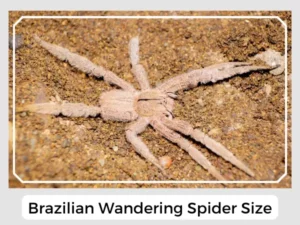
List of Spiders Belonging to This Genus
Physical description and identification.
- Size: They are large in size, with their body being 17- 48mm (.67 – 1.89 inches) long and they also have a leg span of 130 – 150 mm (5.1-5.9 inches).
- Color: The color may vary from one species to the other, though most of them have a brown hairy body, with black spots on their stomach. Some have bright, red hairs on their mouthparts or chelicerae, while others may lack it, a feature that confuses them with species of another genus, particularly the Cupiennius.
- Other characteristics: They often lift their body in an erect posture and hold their frontal legs high to defend themselves against predators.
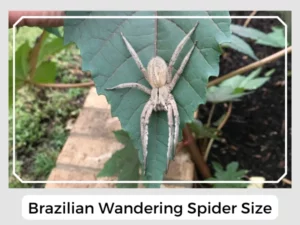
They are safely placed in a silken sac and the female spiders of this genus are known to lay about 1000 of them in her lifetime.
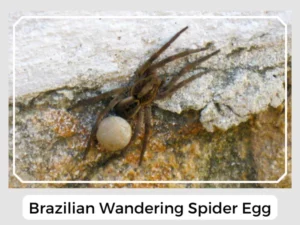
Spiderlings
They remain with their mother for some time after which they disperse to be on their own. The juvenile spiders are known to consume pin crickets as well as non-volatile fruit flies for their diet.
The spiders of this genus do not build webs but walk on the jungle floor, on the lookout for their prey.
Are Brazilian Wandering Spiders Venomous?
Yes, Brazilian Wandering Spiders have strong venom. They use it to catch their food. It’s one of the reasons they’re pretty famous.
Can Brazilian Wandering Spiders Bite?
Yes, they can bite. While they don’t always want to, they might if they feel scared or threatened by something.
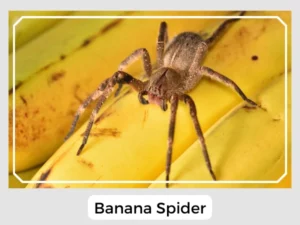
How Fast Can a Brazilian Wandering Spider Kill One?
It has been reported that the bite of species belonging to this genus may result in the victim’s death within one hour after the venom enters the person’s body. However, with effective anti-venom being introduced for treatment in Brazil to combat the toxic effects of these spiders, the incidence of fatalities has been less. In fact, most studies show that death mostly occurs in children below seven years of age. Of all the eight species, P. nigriventer , followed by P. fera, is said to account for most venom intoxications in Brazil.
Ecological Importance and Behavior of the Brazilian Wandering Spider
The Brazilian Wandering Spider, scientifically known as Phoneutria, stands out not just because of its reputation as one of the world’s most venomous spiders , but also due to its ecological significance and unique behavior.
Natural Predator: Despite their fearsome reputation, Brazilian Wandering Spiders are not at the top of the food chain. They fall prey to larger animals and birds. Among their predators are the coatis, certain species of large spiders, and a variety of avian predators.
Prey-Predator Dynamics: The dynamic between the Brazilian Wandering Spider and its prey is a showcase of nature’s balance. While they are efficient hunters, specializing in ambushing their prey, their own survival is constantly under threat from their predators. This cycle ensures that no one species dominates the ecosystem and that biodiversity thrives.
Relationship with Humans: The relationship between humans and the Brazilian Wandering Spider is one of respect and caution. Their venom is potent and can be harmful to humans, although fatal encounters are rare.
Quick Facts
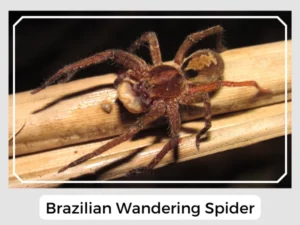
Did You Know
- Species of this genus are known for wandering along the jungle floor during the night which is why they are referred to as “wandering spiders”.
- They are alternately called “banana spiders”, a name that they also share with other species because members of this genus have often been found in banana shipments. Research in shipments going to North America showed that 7 of the 135 spiders found in such shipments were of the Phoneutria genus.
- Phoneutria in Greek means murderess, a name perfectly attributed to its aggressive nature.

Other Spiders in this Family
Wandering spiders.
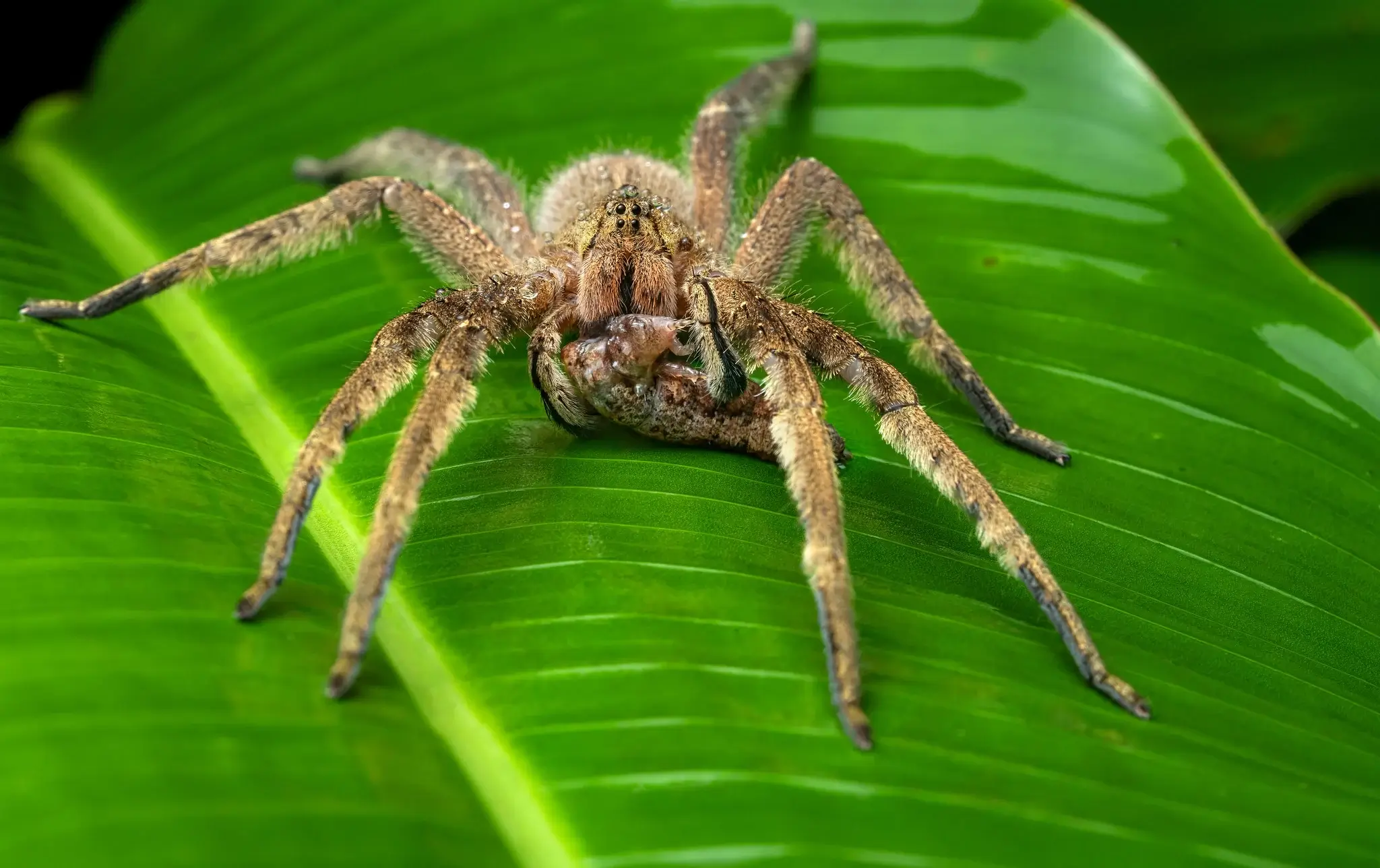
Phoneutria depilata
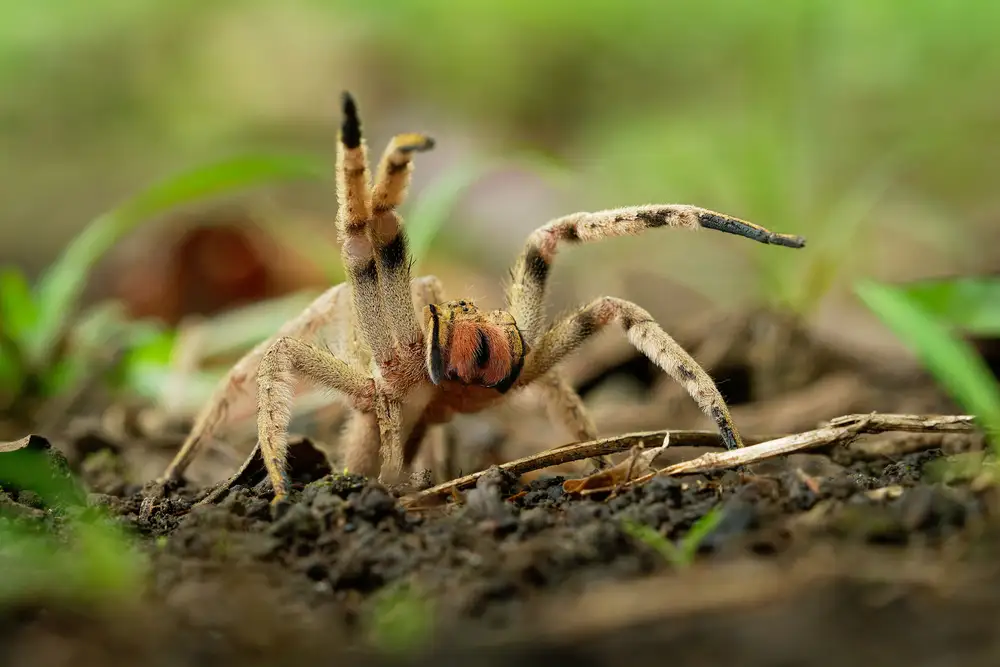
Phoneutria boliviensis
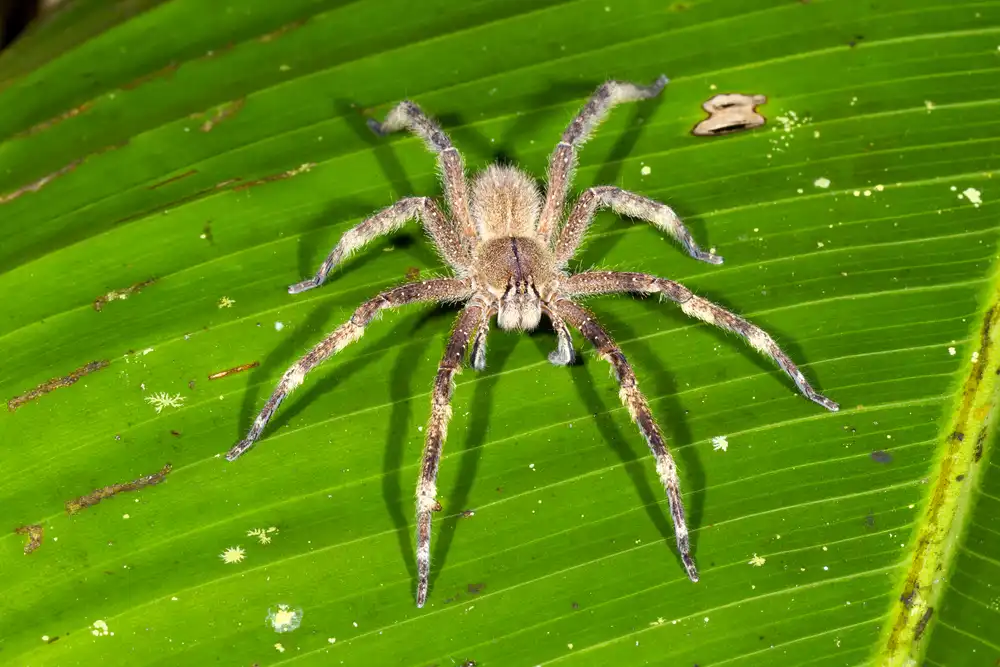
Phoneutria fera
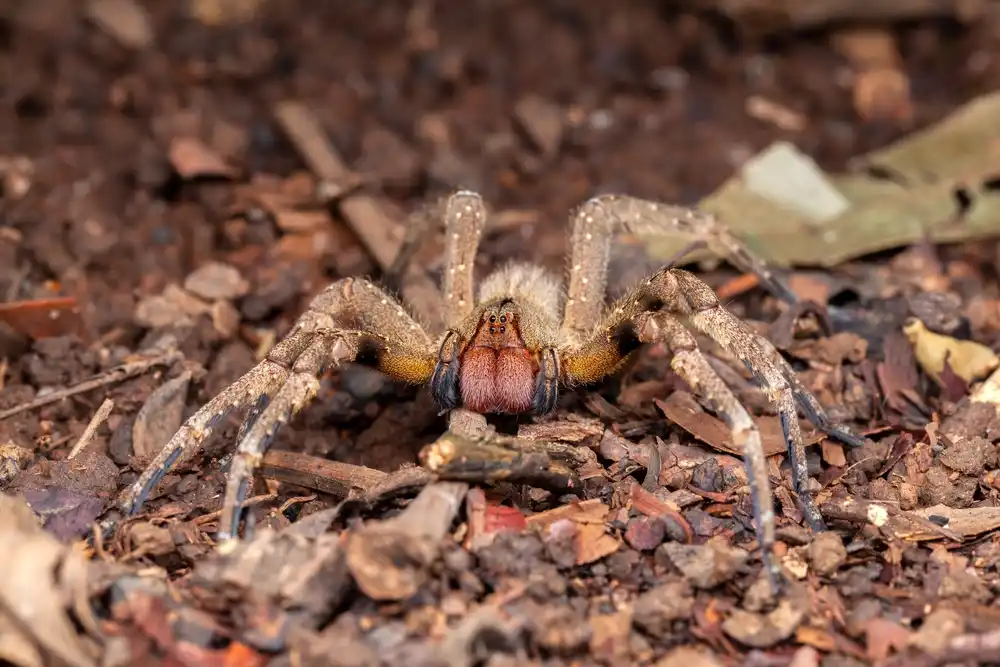
Phoneutria nigriventer
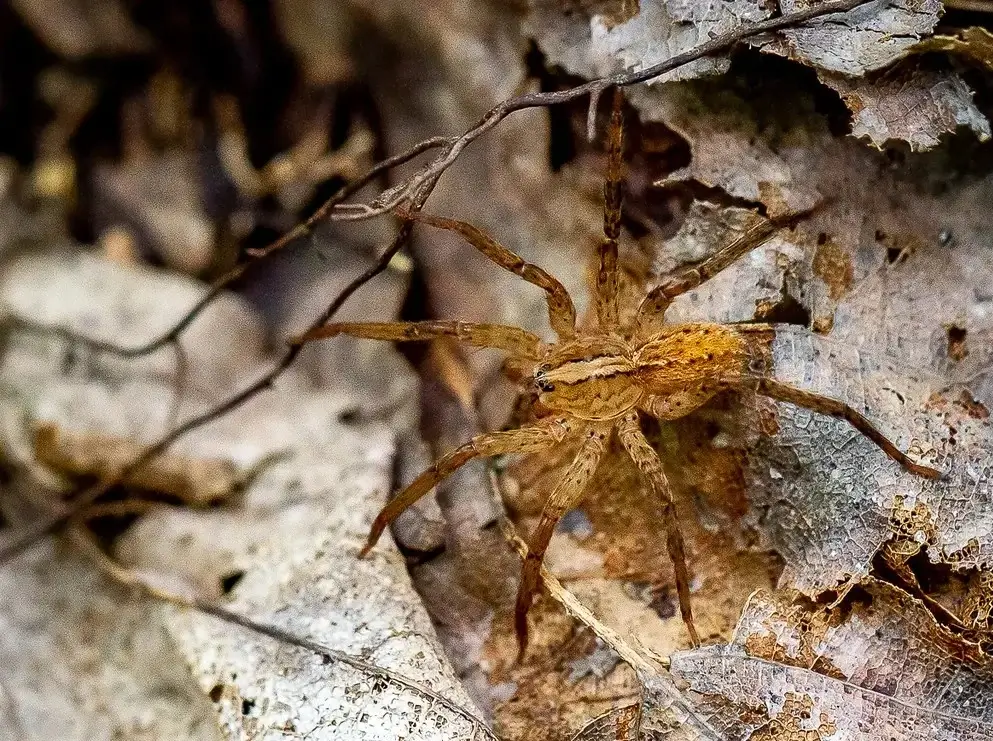
Southeastern Wandering (Anahita punctulata)
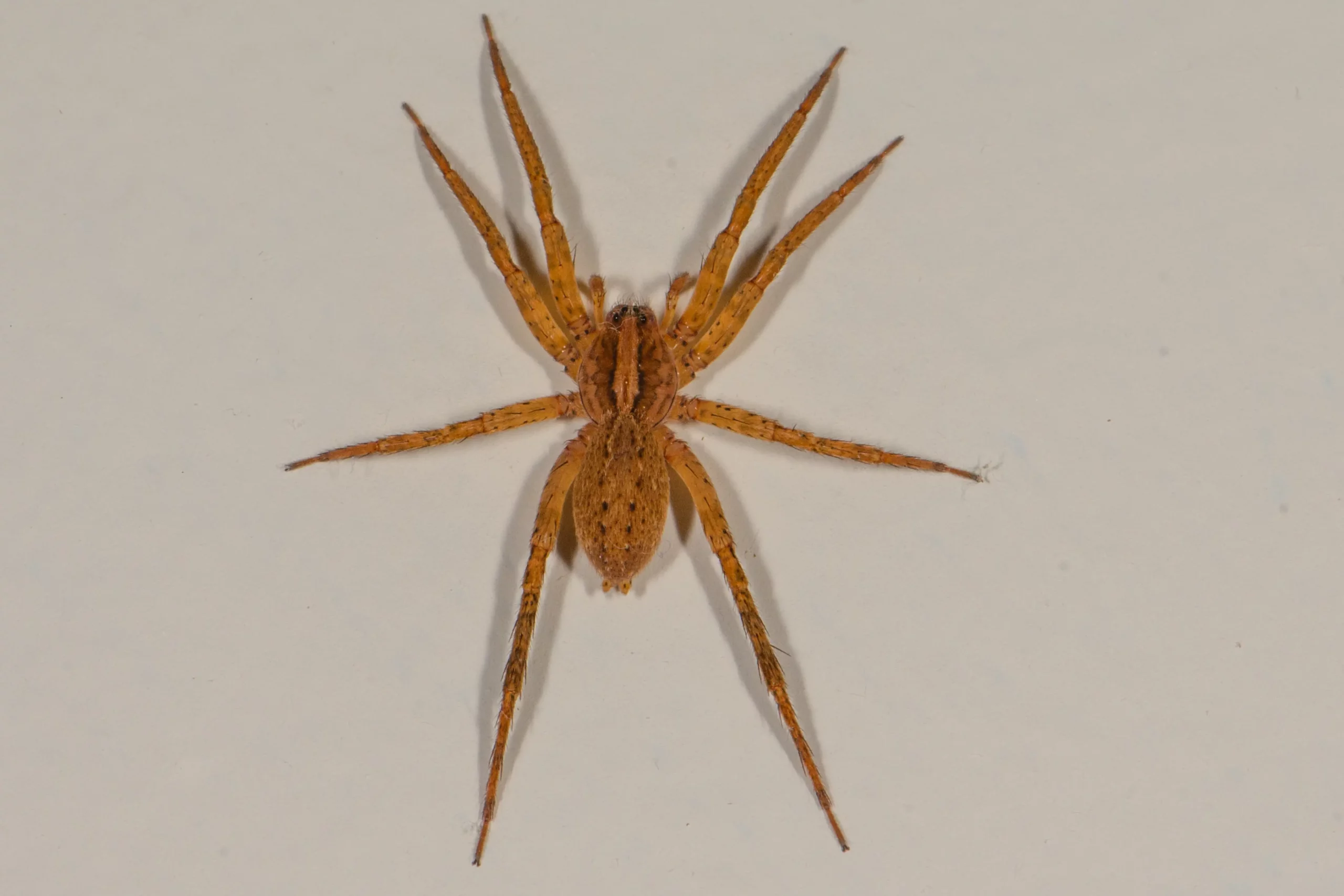
- Terms and Conditions
- Privacy Policy


Where can I see the Brazilian Wandering Spider
Inspiring you to embark on an unforgettable journey, discovering the beauty and wonder of Brazilian Wandering Spider in its natural habitat
The Brazilian Wandering Spider is a venomous spider found in tropical regions of South America. It is a member of the genus Phoneutria, which includes some of the most venomous spiders in the world. The Brazilian Wandering Spider's habitat includes rain forests, banana plantations, and other rural areas.
The Brazilian Wandering Spider is a large, brown spider with long legs. It is sometimes called the "Banana Spider" because it is often found near banana plants. The Brazilian Wandering Spider's venom is highly toxic and can cause severe pain, muscle spasms, and respiratory problems. However, due to its shy nature and relatively small size, the Brazilian Wandering Spider is not considered a major threat to humans.
Despite its dangerous reputation, the Brazilian Wandering Spider is a fascinating creature and a popular subject of study for arachnologists. These spiders have an interesting courtship ritual and are known to be very aggressive when provoked. They are also thought to be one of the few species of spiders that exhibit suicidal behaviour when threatened.
Data Deficient (DD)
How geeky planet works:.
.webp)
Experience your new adventure
.avif)
Discover more about the Brazilian Wandering Spider
View our gallery and watch first hand videos of where you can see the Brazilian Wandering Spider in the wild.

Best time to see the Brazilian Wandering Spider
Geeky facts about the brazilian wandering spider, tours where i can see the brazilian wandering spider.

Inca Trail & Amazon Adventure
12 days from
£2,396 / person

The Best of Brazil & Argentina with Brazil's Amazon
13 days from
£3,493 / person

Ultimate South America with Brazil's Amazon & Galapagos Cruise
30 days from
£10,384 / person

Ecuador: Amazon, Hot Springs & Volcanoes
9 days from
£1,659 / person

Manaus Amazon Jungle Adventure 5D/4N
5 days from
£527 / person

Amazon to the Andes
£1,799 / person.

Andes to Amazon
14 days from
£2,549 / person

Pure Brazil
£5,150 / person.

4 Days Peru Amazon Iquitos Expedition
4 days from
£463 / person

Inca & Amazon Adventure
£4,020 / person.

Amazon, Incas & Titicaca - 13 days
£2,945 / person.

Ecuador - Andes, Amazon and Galapagos Islands
16 days from
£5,795 / person

Cartagena To Manaus - Trans South America
189 days from
£8,355 / person

Galapagos & Amazon
15 days from
£7,699 / person

The Great Amazon Adventure & Galapagos Discovery
11 days from
£1,993 / person

Inca Trail & the Amazon Rainforest
£3,999 / person.

Brazil Uncharted
19 days from
£5,985 / person

3 Nights Package in Amazon Jungle with Aircon
£511 / person.

Amazon Riverboat Adventure In Depth
£2,569 / person.

Inland & Amazon
£1,519 / person.

Ecuador: Cotopaxi & the Amazon Jungle
8 days from
£2,349 / person
Stories about the brazilian wandering spider.

Areas of Natural Beauty where you can see the Brazilian Wandering Spider in the wild

Countries where you can see the Brazilian Wandering Spider

Wildlife in the same biome

Keep me inspired
We'll keep you inspired by sending you in depth information on destinations across the planet, pairing them with well-planned itineraries from niche travel companies who specialise in curated trips and more - straight to your inbox

Stay up to date with notifications from The Independent
Notifications can be managed in browser preferences.
UK Edition Change
- UK Politics
- News Videos
- Paris 2024 Olympics
- Rugby Union
- Sport Videos
- John Rentoul
- Mary Dejevsky
- Andrew Grice
- Sean O’Grady
- Photography
- Theatre & Dance
- Culture Videos
- Fitness & Wellbeing
- Food & Drink
- Health & Families
- Royal Family
- Electric Vehicles
- Car Insurance Deals
- Lifestyle Videos
- Hotel Reviews
- News & Advice
- Simon Calder
- Australia & New Zealand
- South America
- C. America & Caribbean
- Middle East
- Politics Explained
- News Analysis
- Today’s Edition
- Home & Garden
- Broadband deals
- Fashion & Beauty
- Travel & Outdoors
- Sports & Fitness
- Climate 100
- Sustainable Living
- Climate Videos
- Solar Panels
- Behind The Headlines
- On The Ground
- Decomplicated
- You Ask The Questions
- Binge Watch
- Travel Smart
- Watch on your TV
- Crosswords & Puzzles
- Most Commented
- Newsletters
- Ask Me Anything
- Virtual Events
- Wine Offers
- Betting Sites
Thank you for registering
Please refresh the page or navigate to another page on the site to be automatically logged in Please refresh your browser to be logged in
Brazilian wandering spider: Where are they from and how deadly are they?
One was found in a bunch of supermarket bananas in london, article bookmarked.
Find your bookmarks in your Independent Premium section, under my profile

Sign up to the Independent Climate email for the latest advice on saving the planet
Get our free climate email, thanks for signing up to the independent climate email.
The world’s most venomous spider has been delivered to a south London home in a bunch of bananas.
Specialists were called in to trap the Brazilian wandering spider, which ripped its leg off in a bid to escape and left an egg sac full of thousands of baby spiders behind.
The family who received the deadly arachnid in their Waitrose online shop told the Mail on Sunday they were “too traumatised to remain in the house”, while the supermarket apologised for the “distressing” incident.
It was not the first time a Brazilian wandering spider made the long journey to the UK.
In 2005, a chef in Somerset was bitten by a stowaway that had been hiding in bananas delivered to his pub.
He was saved by anti-venom administered after a nearby zoo identified the arachnid from a picture he took on his phone before passing out.
The spiders and their eggs have also been found in bananas from a Tesco in Essex and One Stop in Staffordshire.
Where are they from?
Fortunately, it is very rare to find Brazilian wandering spiders in the UK or anywhere outside their natural habitat in South America.
They live in the forests of Costa Rica, Columbia, Peru, Brazil, and Paraguay and gain their name from the habit of moving across jungle floors at night in search of food.
In the day, they like hiding in places that are dark and moist and are known to favour piles of wood, garages, cupboards, shoes and even heaps of clothes.
The apparent tendency to hide in banana bunches – like in the latest incident – has given them the nickname “banana spider”.
Their scientific name translates as “murderess” in Greek and they are also known as the “armed spider”, because of their unusual attacking stance, and “horse stinger”.
How deadly is it?
The Guinness Book of World Records has named it the most venomous spider in the world for possessing the most active neurotoxic venom of any living spider.
The toxin PhTx3 causes extreme pain, swelling, paralysis, skin cell destruction, fatal breathing complications, heart attacks and painful erections (priapism) in men lasting up to four-hours.
Victims of a Brazilian wandering spider bite can reportedly be killed in an hour.
But few deaths occur because an effective anti-venom is available in Brazil and Guinness claims that people are killed, it is usually in children under the age of seven.
Scientists have reportedly considered investigating the use of the deadly venom as a possible ingredient for drugs treating erectile dysfunction.
What do Brazilian wandering spiders look like?
There are eight known species, with the most dangerous being the Phoneutria fera and the Phoneutria nigriventer.
All vary slightly in appearance but are known for their size, with a leg span of up to 15 cm (6 ins) and body length of up to 5 cm (2 ins).
They are covered with hair and usually dark brown in colour, with some displaying bright red hairs on their venom glands.
When Brazilian wandering spiders feel threatened, they adopt a distinctive “attacking” stance with their front legs in the air, swaying from side to side.
How do they attack?
The spiders use bites as their main form of attack but do not always deliver venom, using it only in an estimated third of bites.
They eat insects and small mammals, including other spiders, amphibians, reptiles and mice, hunting them on the ground and killing with an ambush or direct attack.
Join our commenting forum
Join thought-provoking conversations, follow other Independent readers and see their replies
Subscribe to Independent Premium to bookmark this article
Want to bookmark your favourite articles and stories to read or reference later? Start your Independent Premium subscription today.
New to The Independent?
Or if you would prefer:
Hi {{indy.fullName}}
- My Independent Premium
- Account details
- Help centre
Brazilian Wandering Spider
- Development & Reproduction
- Classification/Phylogeny
Phoneutria fera
This website is home to the deadliest spider known to man: the Brazilian Wandering Spider. I hope you learn a lot about this intriguing, beautiful, yet dangerous creature and come back soon!!
Contact Me:
Jordan Johnson
- Email: [email protected]
This website was produced through the Biology Department at the University of Wisconsin- La Crosse . See web pages similar to this about other interesting organisms here . All pictures and information on this web page were used with permission from their owner

Brazilian Wandering Spider (Phoneutria Nigriventer)
The Brazilian wandering spider (Phoneutria nigriventer), also known as the armed spider or banana spider, is a deadly spider native to South America. This large, venomous arachnid is widely recognised as one of the most venomous spiders in the world. With a range of fascinating behaviours and unique adaptations, the Brazilian wandering spider has become a subject of interest for scientists and enthusiasts alike.
Physical Characteristics
Brazilian wandering spiders are known for their robust build, long legs, and powerful fangs. They are large spiders, with an average leg span of up to 6 inches (15 cm) and a body length that ranges from 1.7 to 2 inches (4.3 to 5 cm). Their size makes them particularly intimidating to encounter, as they are one of the largest spiders in their region.
The spider’s colouration varies depending on the species, but most Brazilian wandering spiders are brownish in colour with black or dark markings. This colouration enables them to blend into their natural habitat, making it easier for them to ambush their prey.
Anatomically, these spiders have a robust body, long and thick legs, and powerful fangs that can deliver venomous bites. Their eyes are arranged in two rows, with a total of eight eyes, which gives them a wide field of vision and the ability to detect motion from various angles. Their chelicerae (fang-bearing mouthparts) are large and powerful, capable of piercing the skin and delivering venom to their prey.

Brazilian wandering spiders are primarily found in the tropical rainforests of South America, especially in Brazil, and one species in North America. Their preferred habitat includes a variety of environments ranging from the forest floor to trees and shrubs. The dense vegetation of the rainforest provides them with ample hiding spots, making it easier for them to ambush their prey.
These spiders are highly adaptable and can survive in a range of environments. They have even been found in human settlements, particularly in rural areas where there is less disturbance. In such cases, they may seek refuge in homes, barns, or other structures, especially during periods of heavy rain or when searching for food.
Diet and Hunting Techniques
Brazilian wandering spiders are carnivorous predators that primarily feed on insects, other spiders, and small vertebrates such as lizards and frogs. They have a diverse diet and can consume a wide range of prey, depending on their size and availability.
Unlike many other spiders, Brazilian wandering spiders do not spin webs to catch their prey. Instead, they actively hunt for food, relying on their acute senses, speed, and agility to catch their prey. They use a combination of stealth and ambush tactics to get close to their prey, and then swiftly strike with a venomous bite, immobilising their victim.
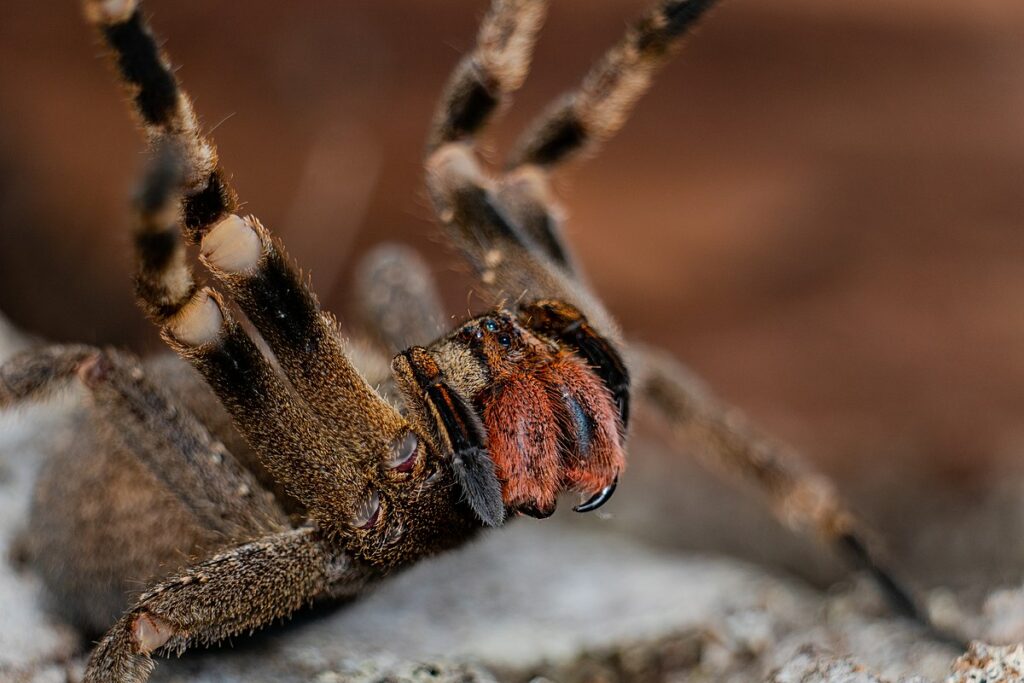
The wandering behaviour of these spiders is what gives them their name. Instead of building a permanent web and waiting for prey to come to them, Brazilian wandering spiders actively search for food. This makes them highly mobile and increases their chances of encountering a wide variety of prey.
When threatened, Brazilian wandering spiders are known for their aggressive behaviour. They may raise their front legs and display their fangs in a defensive posture. This behaviour is a warning to potential predators that they are armed with venom and ready to strike if necessary.
Reproduction
The reproduction process in Brazilian wandering spiders begins with courtship rituals. Males initiate mating by approaching females and signalling their intentions through vibrations and leg movements. Once the female is receptive, the male deposits his sperm into the female’s reproductive organs.
After mating, the female lays a clutch of eggs and guards them until they hatch. The spiderlings then disperse to start their independent lives. As they grow, they moult several times, shedding their exoskeletons and developing into mature spiders.

The Brazilian wandering spider venom is highly potent and contains a mix of toxins, including neurotoxins, proteins, and enzymes. This venom is highly effective at immobilising their prey, making it easier for the spider to consume it.
In humans, the venom can cause a range of symptoms, including intense pain, swelling, excessive sweating, blurred vision, and elevated heart rate. In rare cases, Brazilian wandering spider bite can lead to severe complications or even death. However, with prompt medical treatment, most victims recover without long-term effects.
Brazilian Wandering Spider and Humans
Brazilian wandering spiders are known to occasionally enter human settlements, especially in rural areas. While these encounters can be unnerving, the spiders generally prefer to avoid confrontation with humans.
If you encounter a Brazilian wandering spider, it is important to stay calm and avoid provoking it. If you are bitten, seek medical attention immediately, as prompt treatment is crucial for minimising the effects of the venom.
Conservation Efforts
Conservation efforts are essential for Brazilian wandering spiders, as their natural habitat is increasingly threatened by deforestation, agriculture, and urbanisation. Protecting the rainforests and other natural habitats of these spiders is crucial for their survival.
Interesting Facts
- The venom of the Brazilian wandering spider is being studied for potential medical applications, including pain relief and anti-venom development.
- Despite their reputation as highly venomous spiders, Brazilian wandering spiders play an important role in controlling insect populations in their ecosystems.
- These spiders are also known as “banana spiders” because they have been found in shipments of bananas.
The Brazilian wandering spider (Phoneutria nigriventer) is a remarkable arachnid with unique adaptations and behaviours. Despite their fearsome reputation, these spiders are an essential part of their ecosystems and play a vital role in controlling pest populations. Understanding and respecting these spiders is crucial for their conservation and coexistence with humans.
Sam loves to learn about animals and their habitats. He has been a nature lover from a very young age, and has been writing papers and articles about wildlife for as long as he can remember.
Leave a Comment Cancel Reply
Your email address will not be published. Required fields are marked *
Save my name, email, and website in this browser for the next time I comment.
Brazilian wandering spider (Phoneutria)
- Edit source
Phoneutria , commonly known as Brazilian wandering spiders , armed spiders ("armadeiras", as they are known in Portuguese ), or banana spiders (not to be confused with the relatively harmless Nephila ), are a genus of defensive and venomous spiders of potential medical significance to humans. They are mainly found in tropical South America, with one species in Central America. These spiders are members of the Ctenidae family of wandering spiders.
The Brazilian wandering spiders appear in Guinness World Records from 2010 as the world's most venomous spider. However, several venomous species of arachnid are far more likely to attack a human, and the Guinness book of World Records states that although the Brazilian wandering spider is the most toxic, more deaths actually occur from black widow and brown recluse spider bites, due to the rarity of the Wandering spider biting anyone.
- 1 Description
- 3 Distribution
- 6 Is it Dangerous?
Description [ ]
The genus Phoneutria (Greek for "Murderess") contains eight scientifically described species; the most notorious being P. fera and P. nigriventer . The spiders in the genus can grow to have a leg span of 13 to 15 cm (5.1 to 5.9 in). Their body length ranges from 17 to 48 mm (0.67 to 1.9 in). The genus is distinguished from other related genera such as Ctenus by the presence of dense prolateral scopulae (=a dense brush of fine hairs) on the pedipalp tibiae and tarsi in both sexes. [1] Phoneutria are easily confused with several other non-medically significant ctenids, especially Cupiennius , in which the recently described C. chiapanensis also has bright red hairs on the chelicerae . Additionally, some Phoneutria species lack red hairs on the chelicerae, making it an unreliable identification feature. The presence of a dark linear stripe or stripes on the frontal (=dorsal) palps and presence of a single thin black line running anterior-posterior along the dorsal carapace may help identify Phoneutria . Other useful features are the strong ventral marking on the underside of the legs with contrasting dark mid-segments and lighter joints, and the pattern on the ventral (underside) of the abdomen with several rows of black dots, or an overall reddish colour.
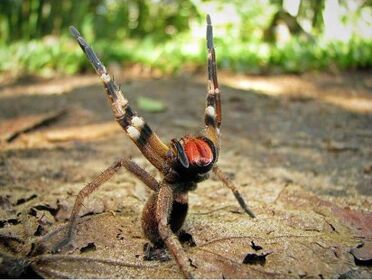
Brazilian Wandering Spider in aggressive pose
The characteristic defensive posture with frontal legs held high is an especially good indicator to confirm a specimen is Phoneutria , especially alongside correct colour patterns. During the defensive display the body is lifted up into an erect position, the first two pairs of legs are lifted high (revealing the conspicuous black/light-banded pattern on the leg underside), while the spider sways from side to side with hind legs in a
cocked position.
Behavior [ ]
Wandering spiders are so-called because they wander the jungle floor at night, rather than residing in a lair or maintaining a web. During the day they hide inside termite mounds, under fallen logs and rocks, and in banana plants and bromeliads . P. nigriventer is known to hide in dark and moist places in or near human dwellings.
P. nigriventer mates during the dry season from April to June, which leads to frequent observations of the species during this time.
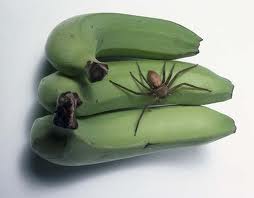
Distribution [ ]
Phoneutria are found in forests from Costa Rica , and throughout South America east of the Andes into northern Argentina , including Colombia , Venezuela , the Guianas , Ecuador , Peru , Bolivia , Brazil and Paraguay . Three species ( P. reidyi, P. boliviensis and P. fera ) are found in the Amazon region , one species ( P. fera ) is restricted to the Amazon, and one ( P. boliviensis ) ranges into Central America in Panama and Costa Rica . The remaining species are restricted to Atlantic Forest of Argentina, Paraguay and Brazil, including forest fragments in the Cerrado savanna. In Brazil, Phoneutria is only absent in the northeastern region north of Salvador, Bahia .
Phoneutria has been introduced to Chile and Uruguay .
Species [ ]
As of early 2012, this genus contains eight species:
- Phoneutria bahiensis Simó & Brescovit, 2001 — Atlantic rainforest of Brazil.
- Phoneutria boliviensis ( F. O. Pickard-Cambridge , 1897) — Central, South America.
[Officially reported in Costa Rica, Panama, Colombia, Peru, Ecuador Bolivia]
- Phoneutria eickstedtae Martins & Bertani, 2007 — Brazil
- Phoneutria fera Perty , 1833 — Ecuador, Peru, Brazil, Surinam, Guyana.
- Phoneutria keyserlingi (F. O. Pickard-Cambridge], 1897) — Atlantic rainforest of Brazil.
- Phoneutria nigriventer ( Keyserling , 1891) — Brazil, northern Argentina; introduced to Uruguay.
- Phoneutria pertyi (F. O. Pickard-Cambridge, 1897) — Atlantic rainforest of Brazil.
- Phoneutria reidyi (F. O. Pickard-Cambridge, 1897) — Venezuela, Peru, Brazil, Guyana.
Toxicity [ ]
P. fera and P. nigriventer are widely considered the most venomous species of spider. Its venom contains a potent neurotoxin , known as PhTx3 , which acts as a broad-spectrum calcium channel blocker that inhibits glutamate release, calcium uptake and also glutamate uptake in neural synapses . At deadly concentrations, this neurotoxin causes loss of muscle control and breathing problems, resulting in paralysis and eventual asphyxiation . In addition, the venom causes intense pain and inflammation following a bite due to an excitatory effect the venom has on the serotonin 5-HT4 receptors of sensory nerves. This sensory nerve stimulation causes a release of neuropeptides such as substance P which triggers inflammation and pain.
Aside from causing intense pain, the venom of the spider can also cause priapism in humans. Erections resulting from the bite are uncomfortable, can last for many hours and can lead to impotence. A component of the venom ( Tx2-6 ) is being studied for use in erectile dysfunction treatments.
The amount of P. nigriventer venom necessary to kill a 20 g mouse has been shown to be only 6 μg intravenously and 134 μg subcutaneously as compared to 110 μg and 200 μg respectively for Latrodectus mactans (Southern black widow). This ranks Phoneutria venom among the most deadly spider venoms to mice.
Is it Dangerous? [ ]
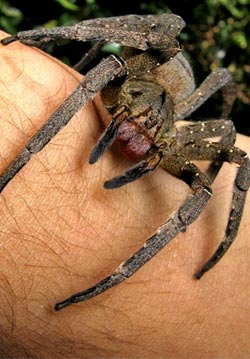
a Person with larger Testicles than Brains
Phoneutria includes some of the relatively few species of spiders known to present a threat to human beings. Danger to humans is not merely a question of toxicity , but requires the capacity to deliver the venom, a sufficient quantity of venom , a disposition that makes a bite likely and proximity to human habitation. The actual incidence of death or serious injury must also be considered.
Spider mouthparts are adapted to envenom very small prey; they are not well-adapted to attacking large mammals such as humans. Some experts believe that various spiders like Phoneutria can deliver a "dry" bite to purposely conserve their venom, as opposed to a more primitive spider like Atrax that usually delivers a full load. A study in March 2009 suggests that Phoneutria inject venom in approximately one-third of their bites, and only a small quantity in one-third of those cases. Another study similarly suggested that only 2.3 percent of bites (mainly in children) were serious enough to require antivenom . However, other studies, as cited in the Wolfgang Bücherl studies, showed that the toxicity of Phoneutria venom was clearly more virulent than both Latrodectus and Atrax . Research in this area is hindered by the difficulty of identifying particular species. Nevertheless, there are well-attested instances of death. In one case, a single spider killed two children in São Sebastião . The spider was positively identified as a Phoneutria by Wolfgang Bücherl.
Despite their reputation as the world's deadliest spiders, there are multiple studies that call into question their capacity for fatal human envenomation, though some of these are labeled with a level of uncertainty, as Phoneutria are often confused with other genera of ctenids or the lycosids or other large labidognatha spiders. Of the eight described species, P. nigriventer and P. fera most frequently receive mention in mass-media publications. P. nigriventer is the species responsible for most cases of venom intoxication in Brazil because it is commonly found in highly populated areas of southeastern Brazil , such as the states of São Paulo , Minas Gerais , Rio de Janeiro and Espírito Santo . The species P. fera is native to the northern portion of South America in the Amazon of Brazil, Venezuela , Ecuador , Peru and the Guyanas .
The spider's wandering nature is another reason it is considered so dangerous. In densely populated areas, Phoneutria species usually search for cover and dark places to hide during daytime, leading it to hide within houses, clothes, cars, boots, boxes and log piles, thus generating accidents when people disturb it. Its other common name, "banana spider", comes from its tendency to hide in banana bunches or plantations, and it is occasionally found as a stowaway within shipments of bananas . These spiders can also appear in banana crates sent to grocery stores and bulk food centers around the world. One such instance happened in 2005 with a shipment of bananas arriving at Bridgwater, England, when a man was bitten by a P. fera ; however, due to quick medical care he survived, taking nearly a week to recover from the bite following treatment.
- 1 Kite Spider (Gasteracantha cancriformis)
- 2 Brazilian wandering spider (Phoneutria)
- 3 Wolf Spider (Lycosidae)

COMMENTS
Phoneutria is a genus of spiders in the family Ctenidae.They are mainly found in northern South America, with one species in Central America. [2] Members of the genus are commonly referred to as Brazilian wandering spiders. [3] Other English names include armed spiders (armadeiras in Brazilian Portuguese) and banana spiders (a name shared with several others).
Learn about the Brazilian Wandering Spider, a highly venomous and aggressive spider that lives in South and Central America. Find out its characteristics, diet, reproduction, venom and how to avoid its bite.
Brazilian wandering spiders are large, with bodies reaching up to 2 inches (5 centimeters) and a leg span of up to 7 inches (18 cm), according to the Natural History Museum in Karlsruhe, Germany ...
Phoneutria nigriventer is a species of medically-significant spider in the family Ctenidae, found in the Southern Cone of South America (Brazil, Uruguay, Paraguay, and Argentina). [1] Along with other members of the genus, they are often referred to as Brazilian wandering spiders. [2]Its bite can cause severe symptoms, including increased pulse, blood pressure, and respiratory rate ...
Brazilian Wandering Spider Profile. There are more than 50,000 species of spider, and the vast majority are less dangerous than a honeybee. Almost none are aggressive, and of those with medically significant venom, only a small percentage are capable of causing death. ... Location: South and Central America: Lifespan: 2 years: Size: 13 - 18cm ...
Within 30 minutes or so, these symptoms become systemic and include irregular heartbeat, high or low blood pressure, abdominal cramping, hypothermia, nausea, vertigo, blurred vision and convulsions. If you are bitten by any species of the wandering spider, you should seek emergency treatment, regardless of how the bite appears to be initially.
Brazilian Wandering Spider Size. Being quite large and impressive compared to most arachnids, adult Brazilian Wandering Spiders can reach a leg span of up to 7 inches (18 cm). The body size excluding the legs can be up to 2 inches (5 cm). Their size contributes to their intimidating presence.
Wandering spiders (Ctenidae) are a family of spiders that includes the Brazilian wandering spiders.These spiders have a distinctive longitudinal groove on the top-rear of their oval carapace similar to those of the Amaurobiidae. [1] They are highly defensive [2] and venomous nocturnal hunters. Wandering spiders are known to hunt large prey, for example hylid species Dendropsophus branneri. [3]
Size and weight. The Brazilian wandering spider is a creepy crawly giant. Their bodies can grow up to 2 inches (5 centimeters) long, but that's not the scary part. Their legs can span a whopping 7 inches (18 cm), making them look even bigger. They are one of the biggest true spiders by body weight and size.
The Brazilian wandering spider, scientifically known as Phoneutria, Maximilian Perty kickstarted the Phoneutria genus in 1833. The name comes from the Greek word φονεύτρια, which means "murderess" and falls under the Animalia kingdom, Arthropoda phylum, and Arachnida class. Within Arachnida, it is classified in the order Araneae ...
Other articles where Brazilian wandering spider is discussed: wandering spider: The Brazilian wandering spiders, Phoneutria fera and P. nigriventer, are sometimes also referred to as banana spiders because they are frequently found on banana leaves. They have an aggressive defense posture, in which they raise their front legs straight up into the air. Phoneutria are venomous,…
Adults. Size: They are large in size, with their body being 17- 48mm (.67 - 1.89 inches) long and they also have a leg span of 130 - 150 mm (5.1-5.9 inches). Color: The color may vary from one species to the other, though most of them have a brown hairy body, with black spots on their stomach. Some have bright, red hairs on their mouthparts ...
The Brazilian Wandering Spider is a venomous spider found in tropical regions of South America. It is a member of the genus Phoneutria, which includes some of the most venomous spiders in the world. The Brazilian Wandering Spider's habitat includes rain forests, banana plantations, and other rural areas. . The Brazilian Wandering Spider is a ...
Phoneutria fera is a species of spider with medically significant venom in the family Ctenidae found in South America (Colombia, Ecuador, Peru, Brazil, Suriname, and Guyana). [1] It is commonly known as the Brazilian wandering spider and the banana spider, [2] although these names are applied to other species in the genus Phoneutria, particularly Phoneutria nigriventer.
Victims of a Brazilian wandering spider bite can reportedly be killed in an hour. But few deaths occur because an effective anti-venom is available in Brazil and Guinness claims that people are ...
wandering spider, (family Ctenidae), any member of the family Ctenidae (order Araneida), a small group of large spiders of mainly tropical and subtropical regions, commonly found on foliage and on the ground. Their first two legs are armed with strong bristles on the lower side. Cupiennius salei, found in rainforests in Central and South America, has a characteristic banding pattern on its ...
Habitat. The geuns Phoneutria is found in southern Central America, and down throughout most of South America including east of the Andes and down into Argentina. Specifically P. fera is restricted to the Brazilian rainforest area, as well as the more urban areas of Brazil but also up into northern South America. This spider has a wandering nature which commonly causes it to find cover in dark ...
The Brazilian wandering spider (Phoneutria nigriventer), also known as the armed spider or banana spider, is a deadly spider native to South America. This large, venomous arachnid is widely recognised as one of the most venomous spiders in the world. With a range of fascinating behaviours and unique adaptations, the Brazilian wandering spider ...
The Brazilian wandering spiders appear in Guinness World Records from 2010 as the world's most venomous spider. However, several venomous species of arachnid are far more likely to attack a human, and the Guinness book of World Records states that although the Brazilian wandering spider is the most toxic, more deaths actually occur from black ...